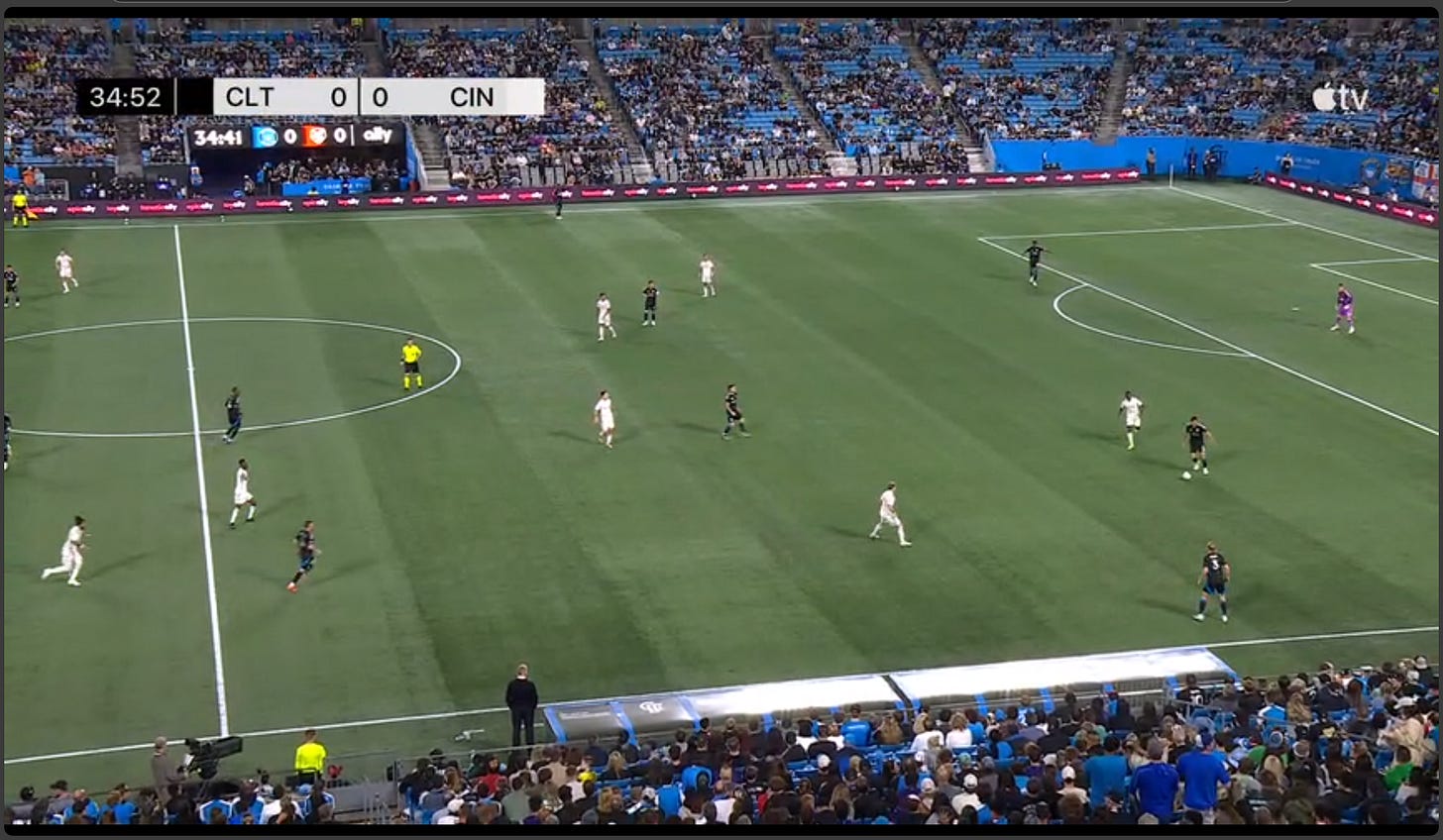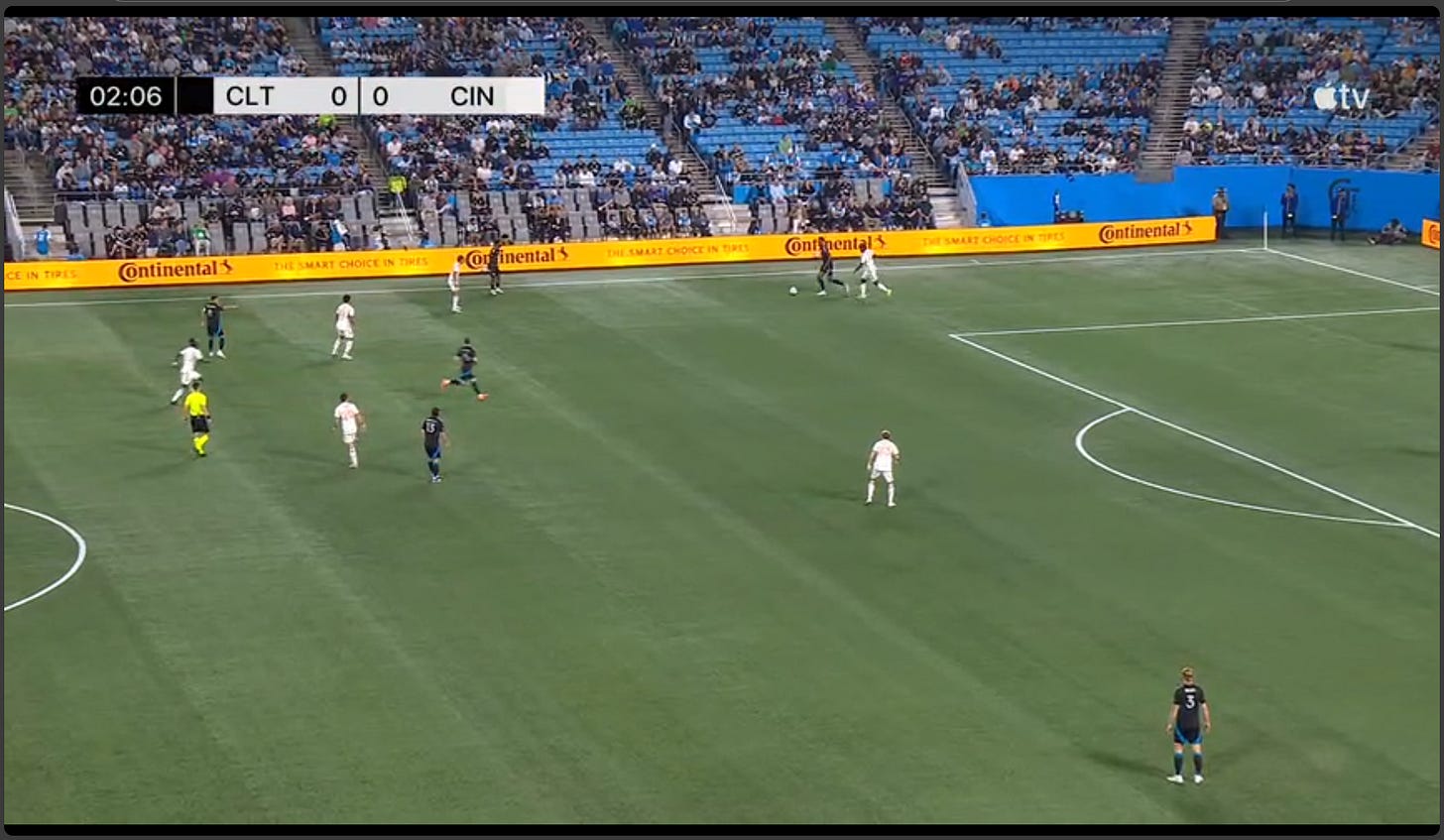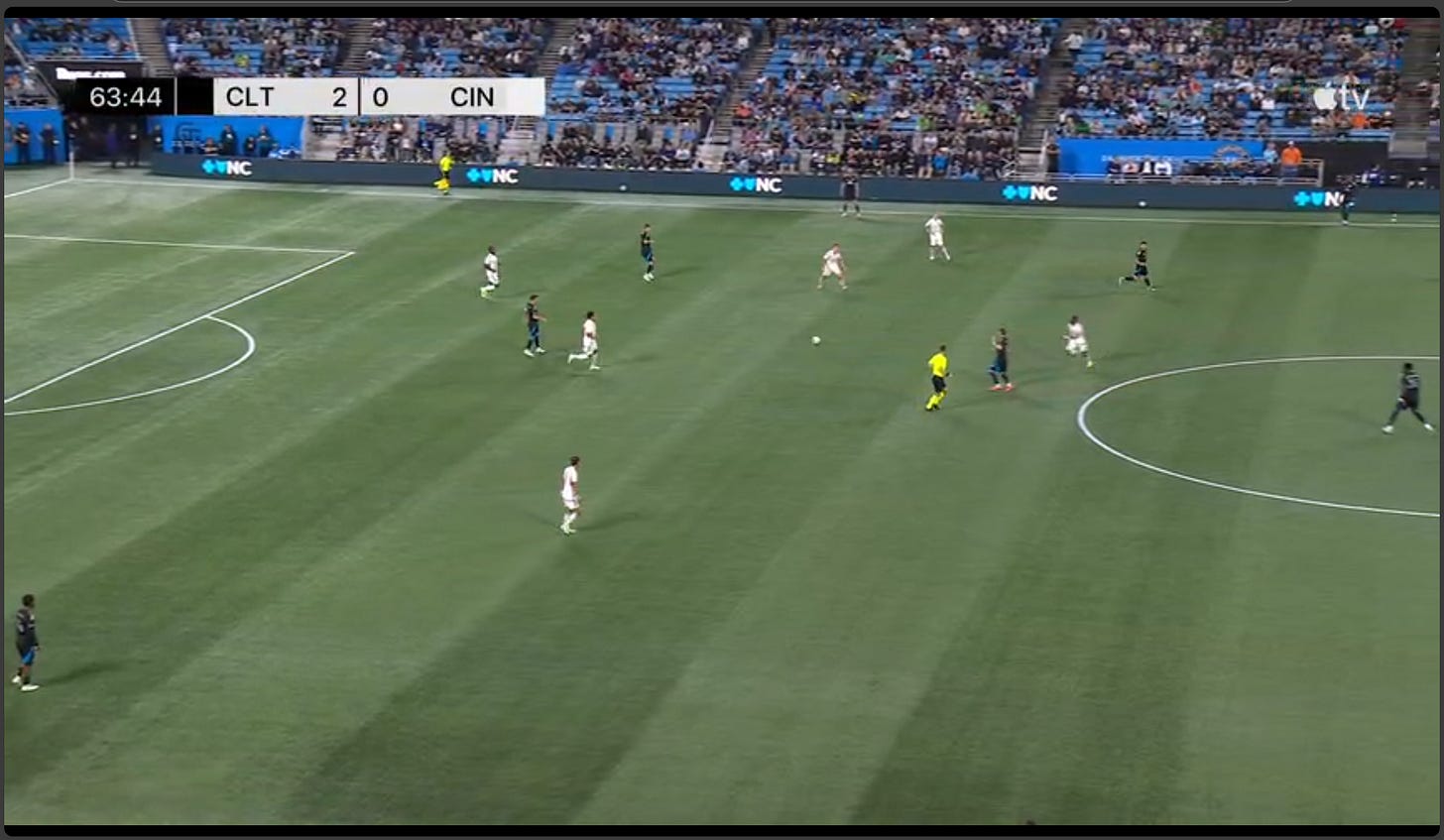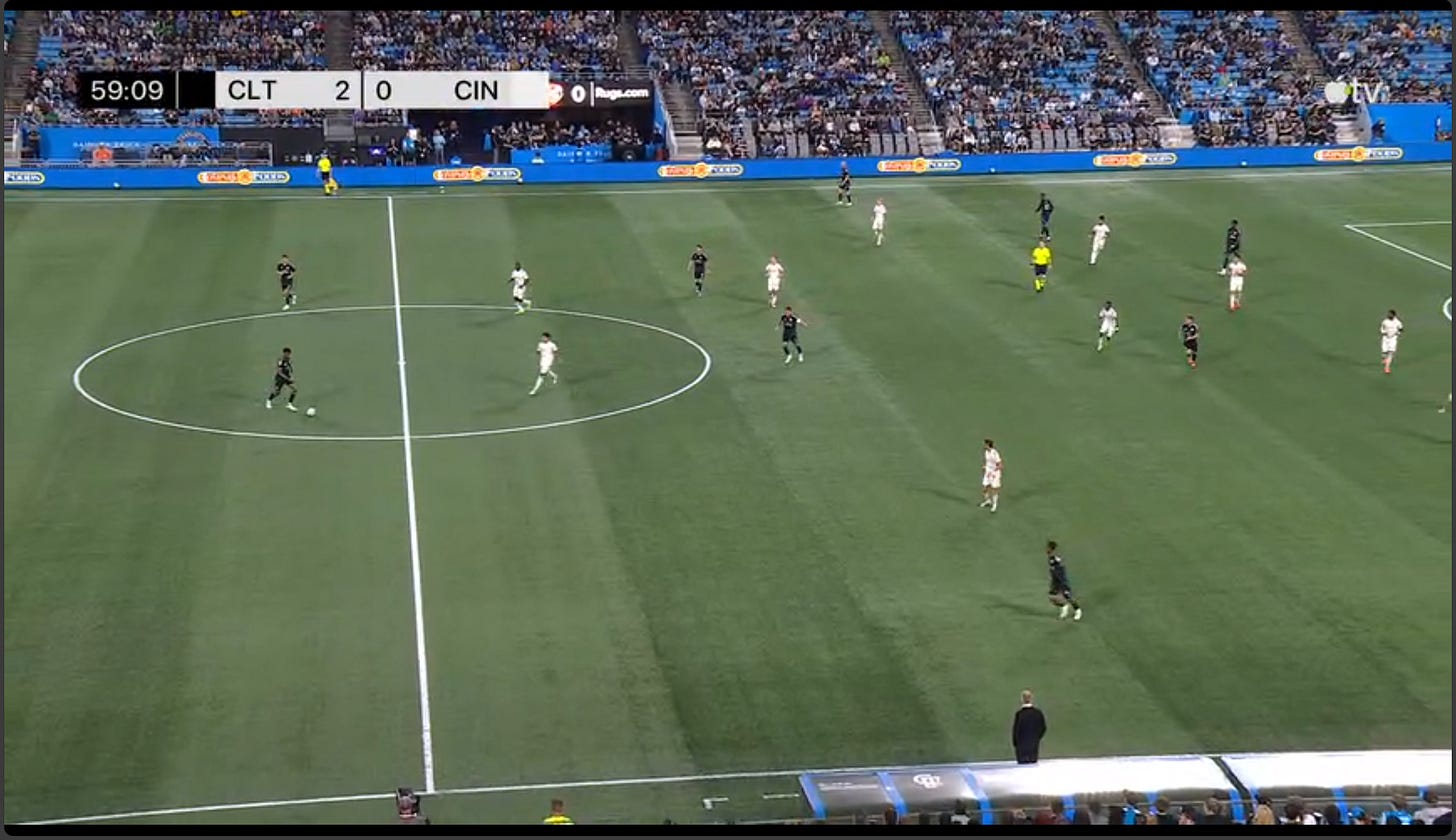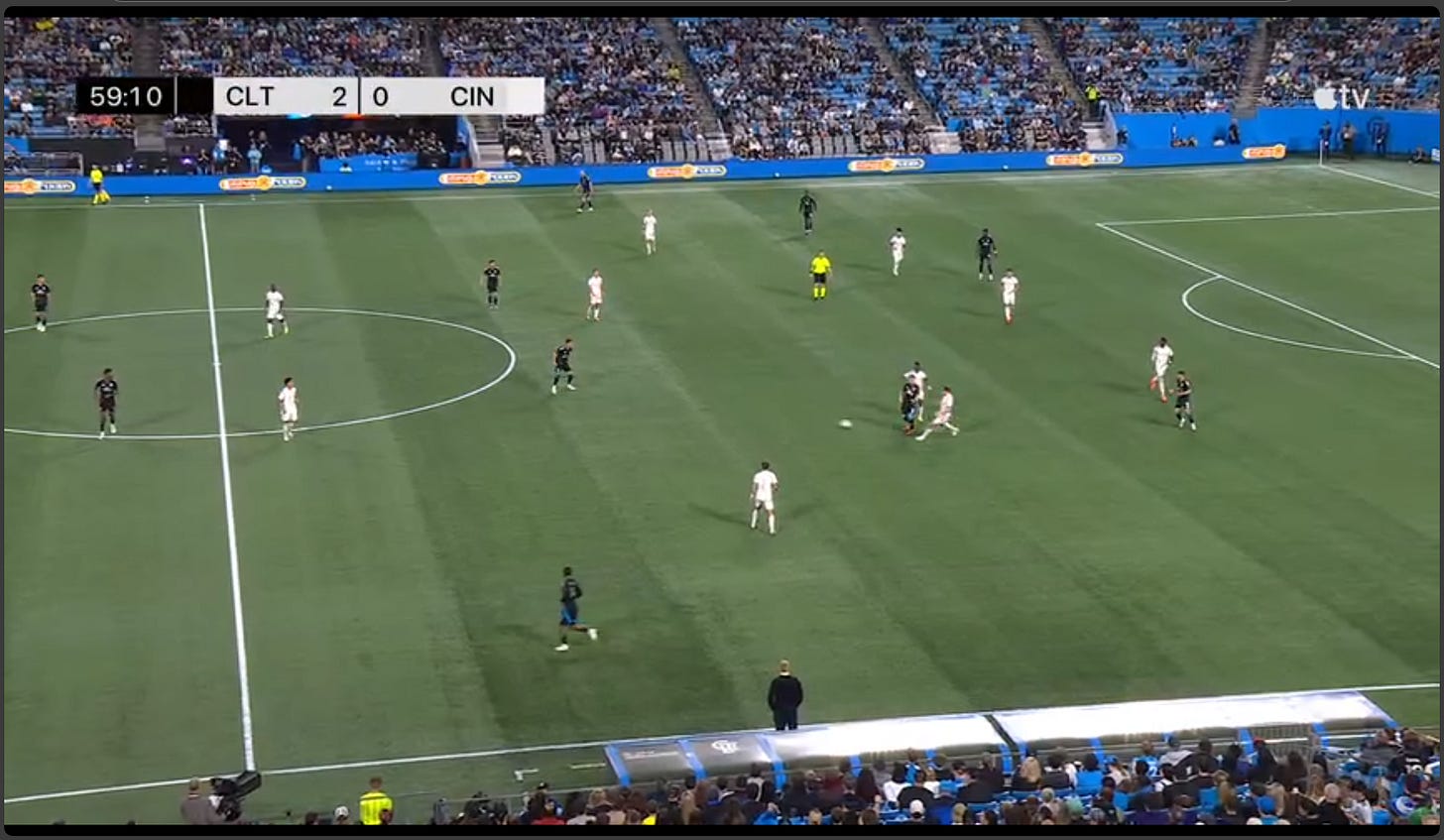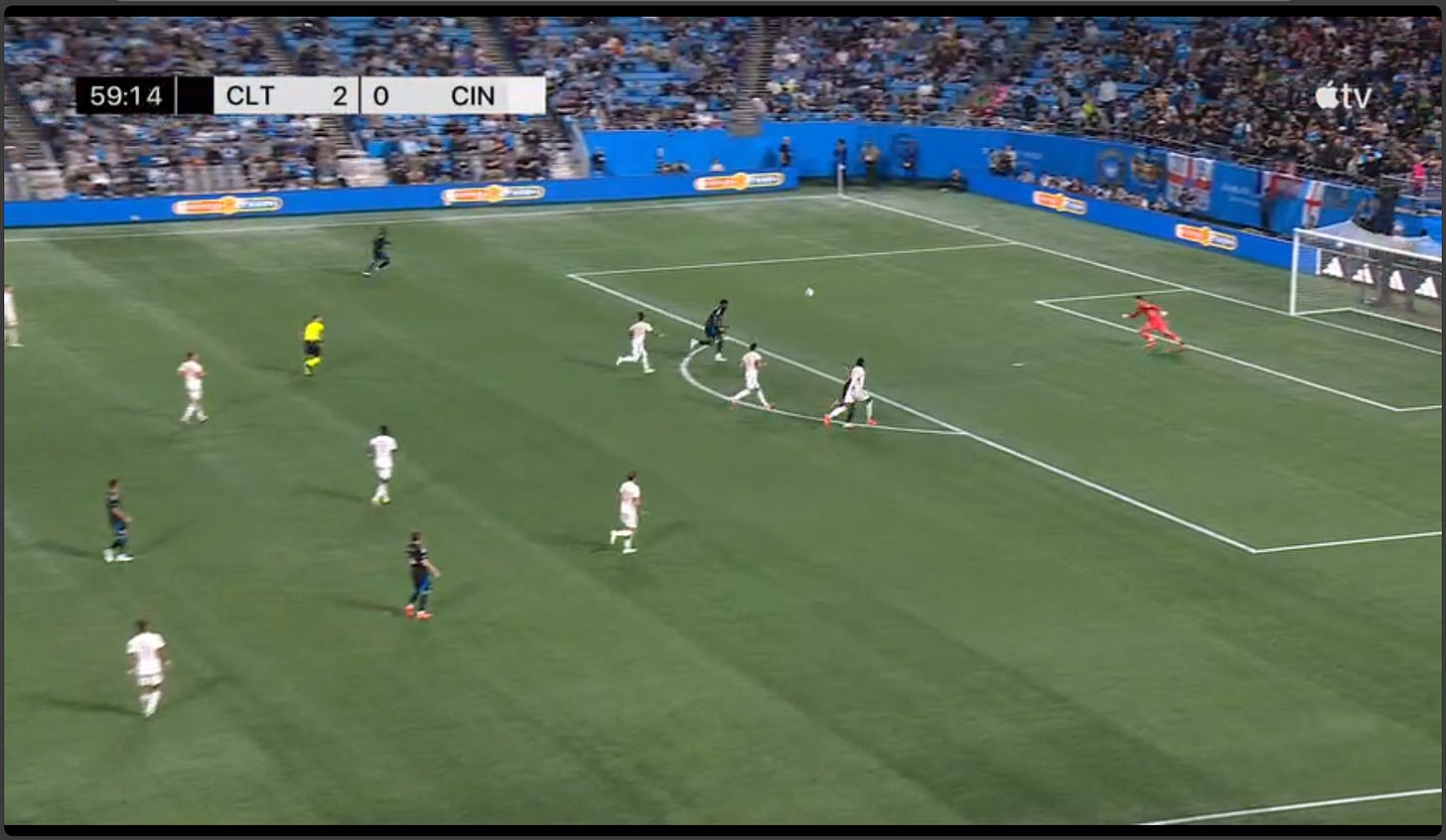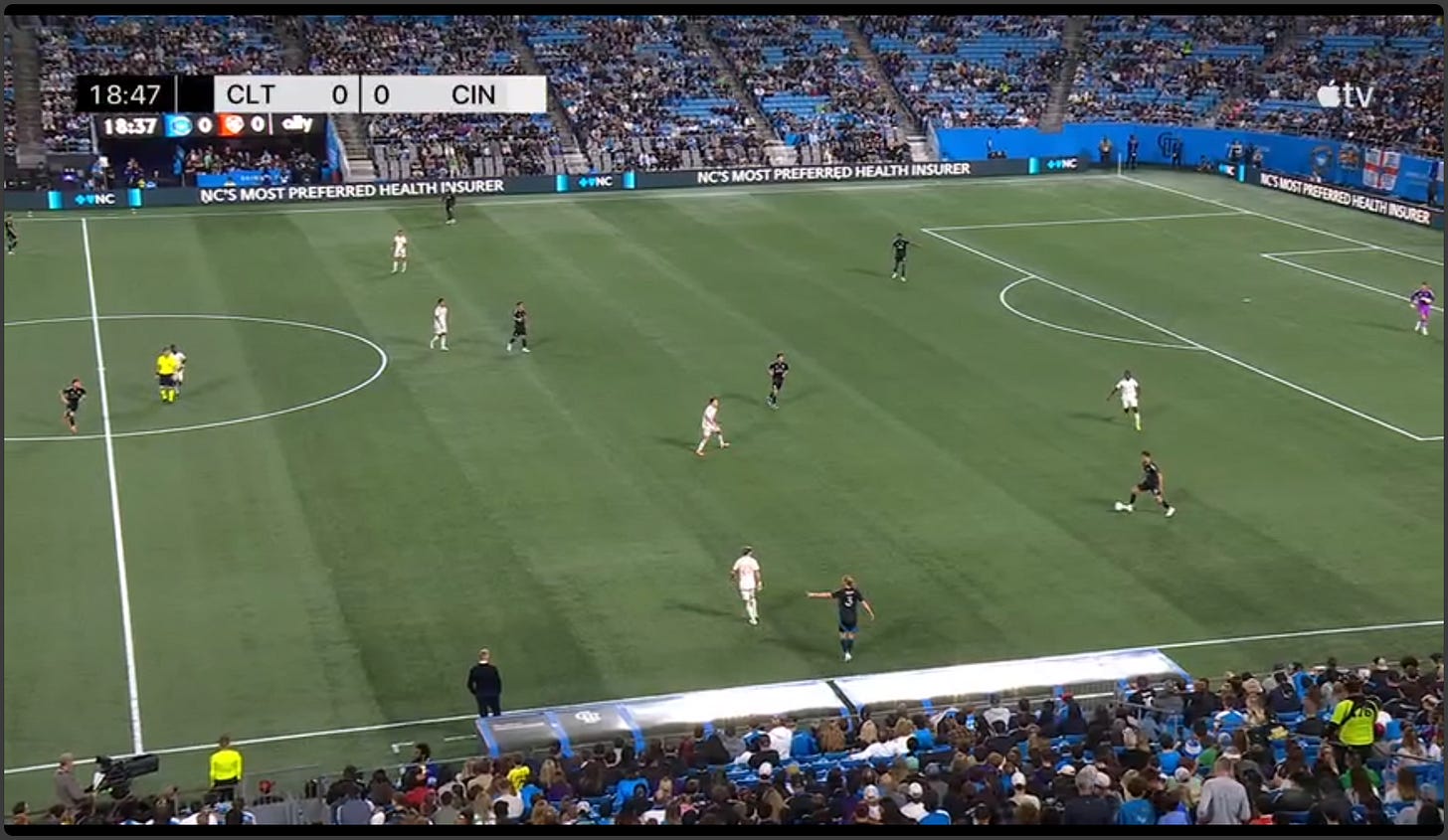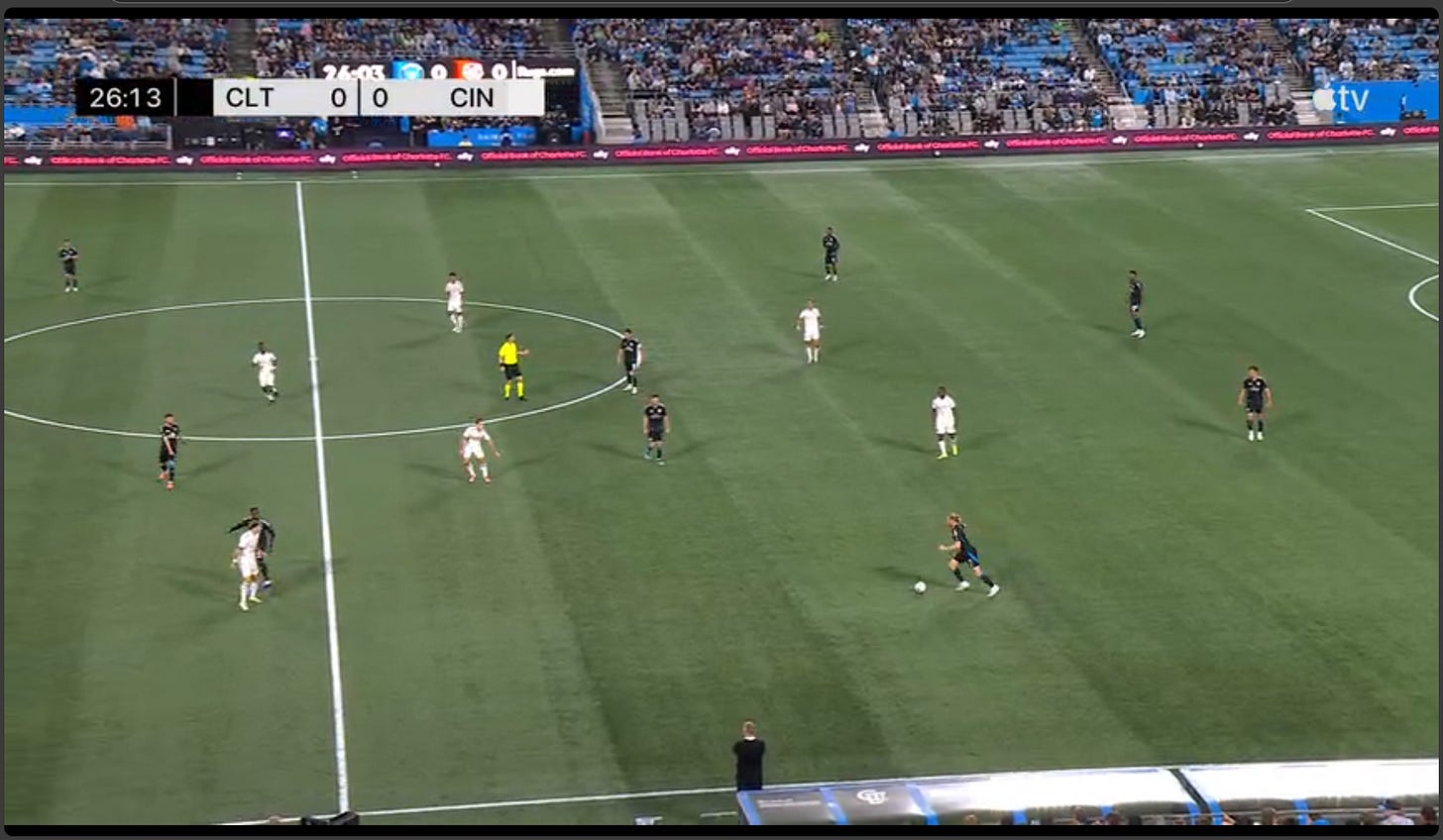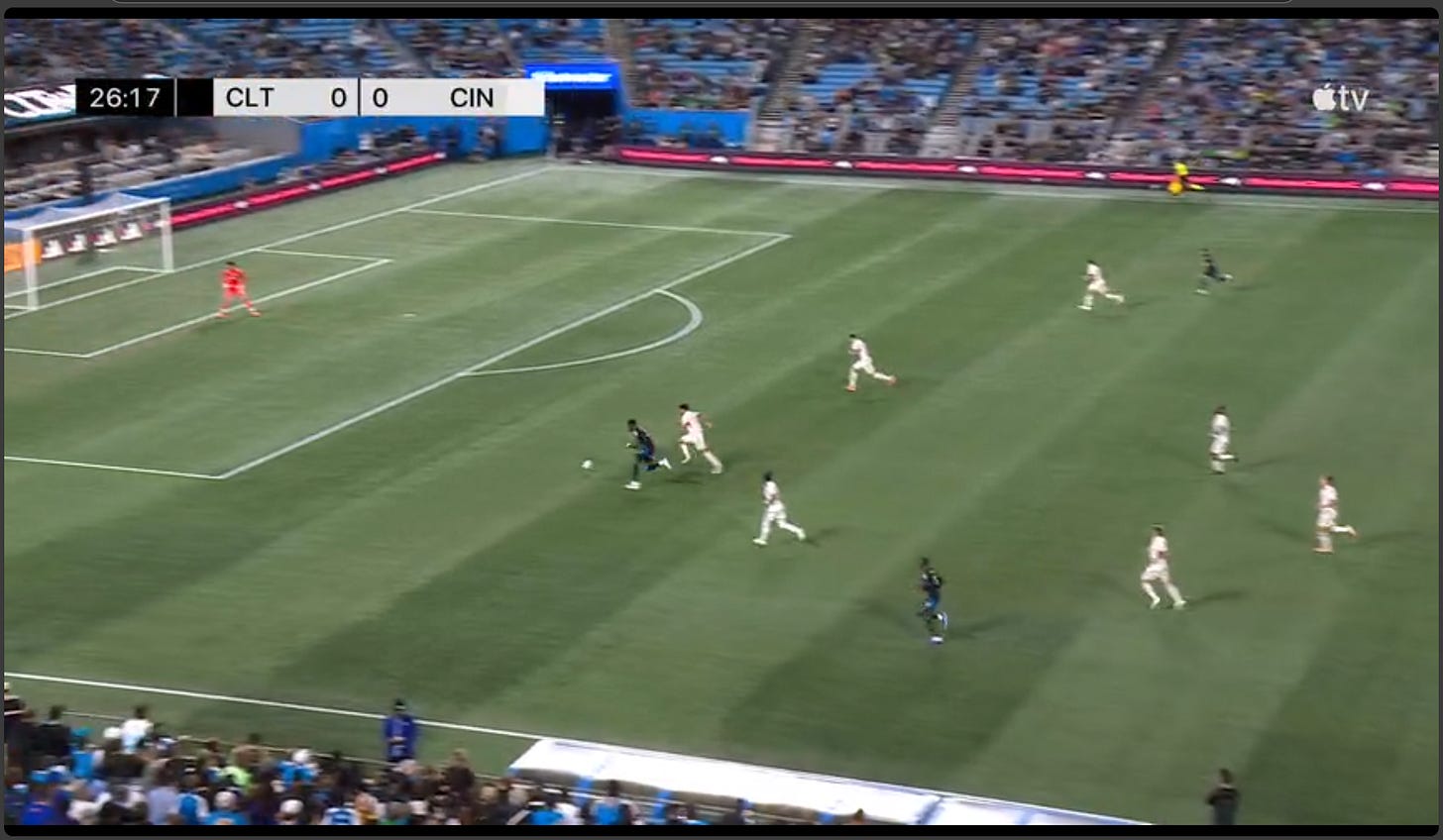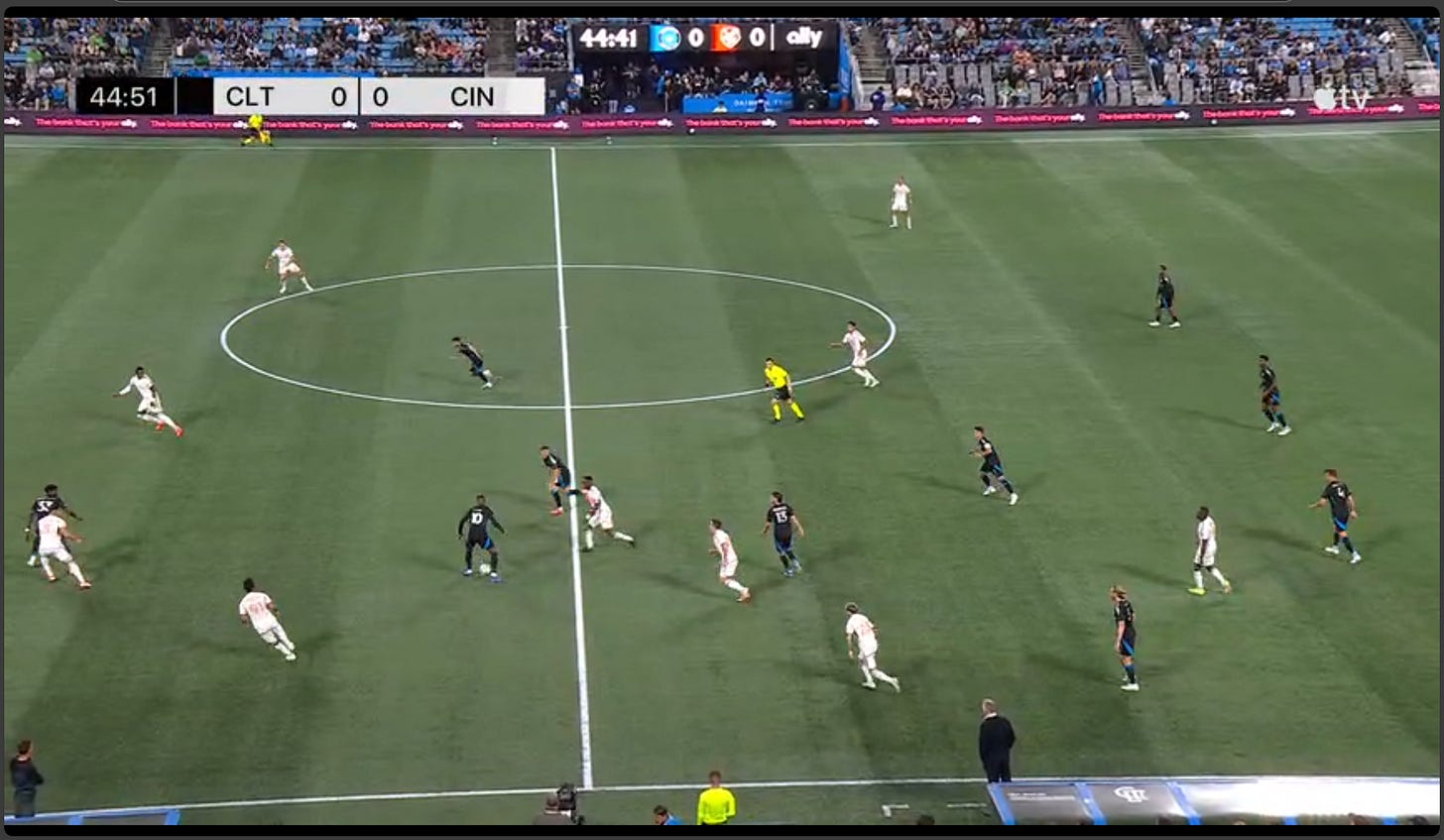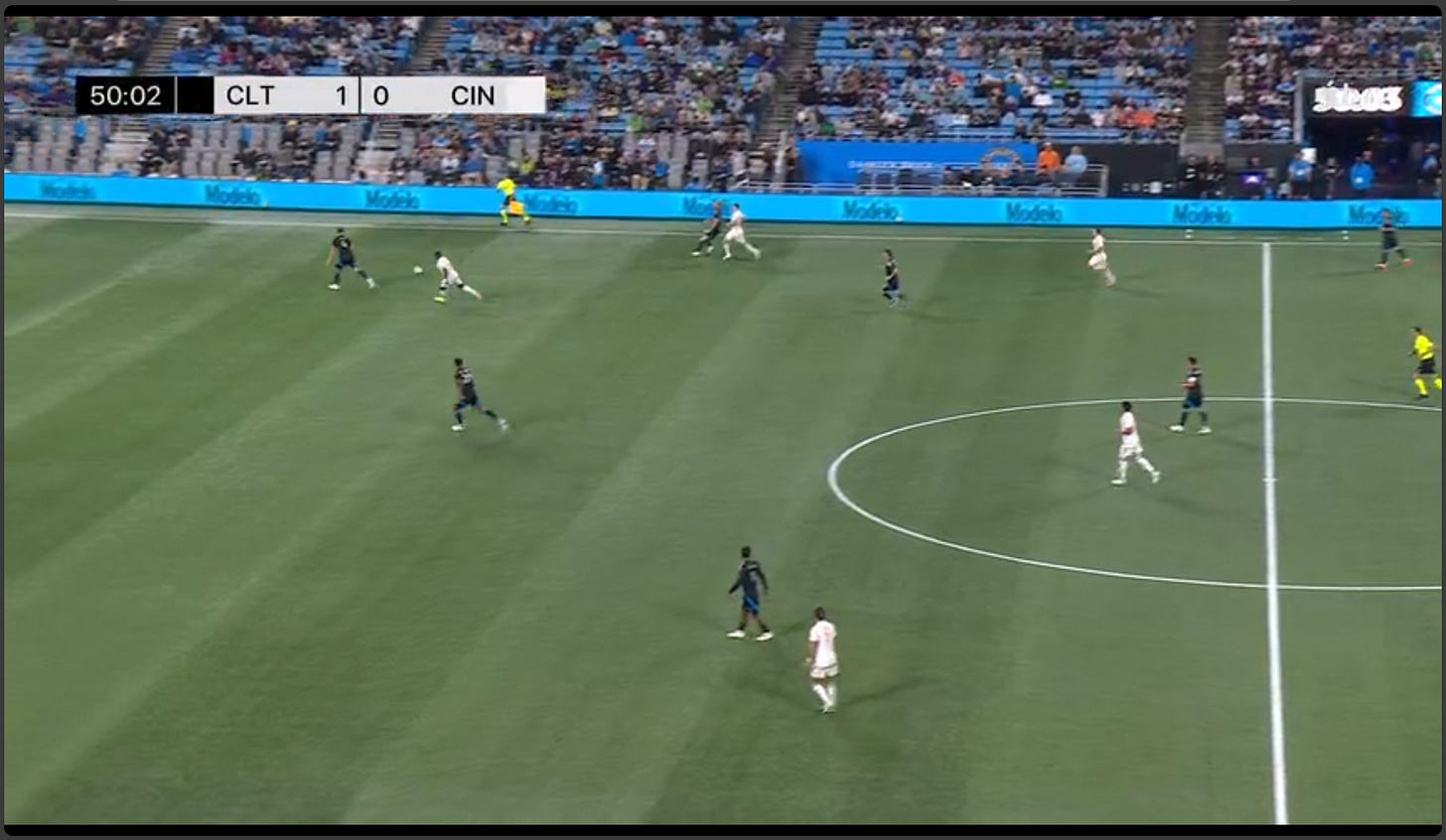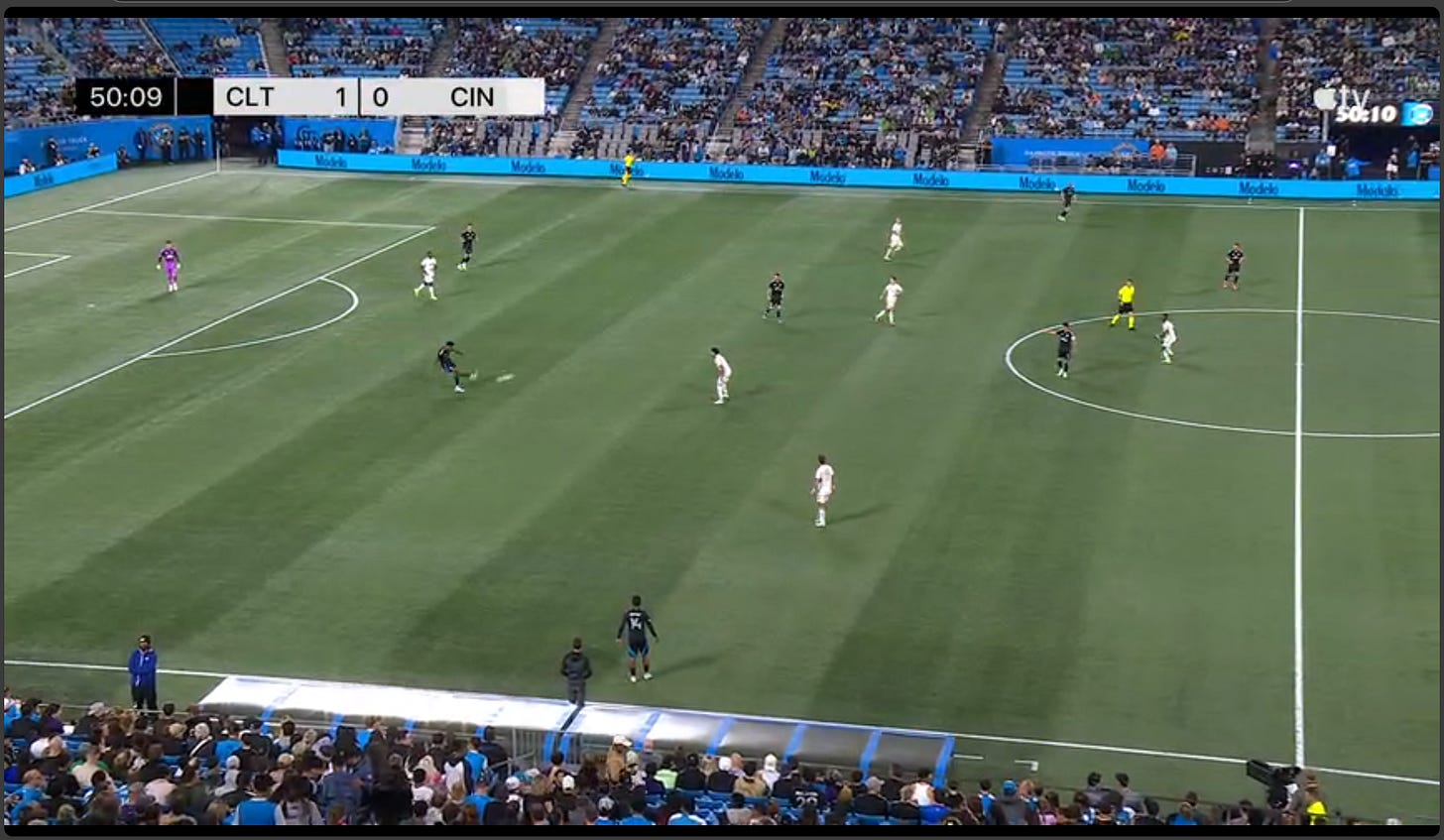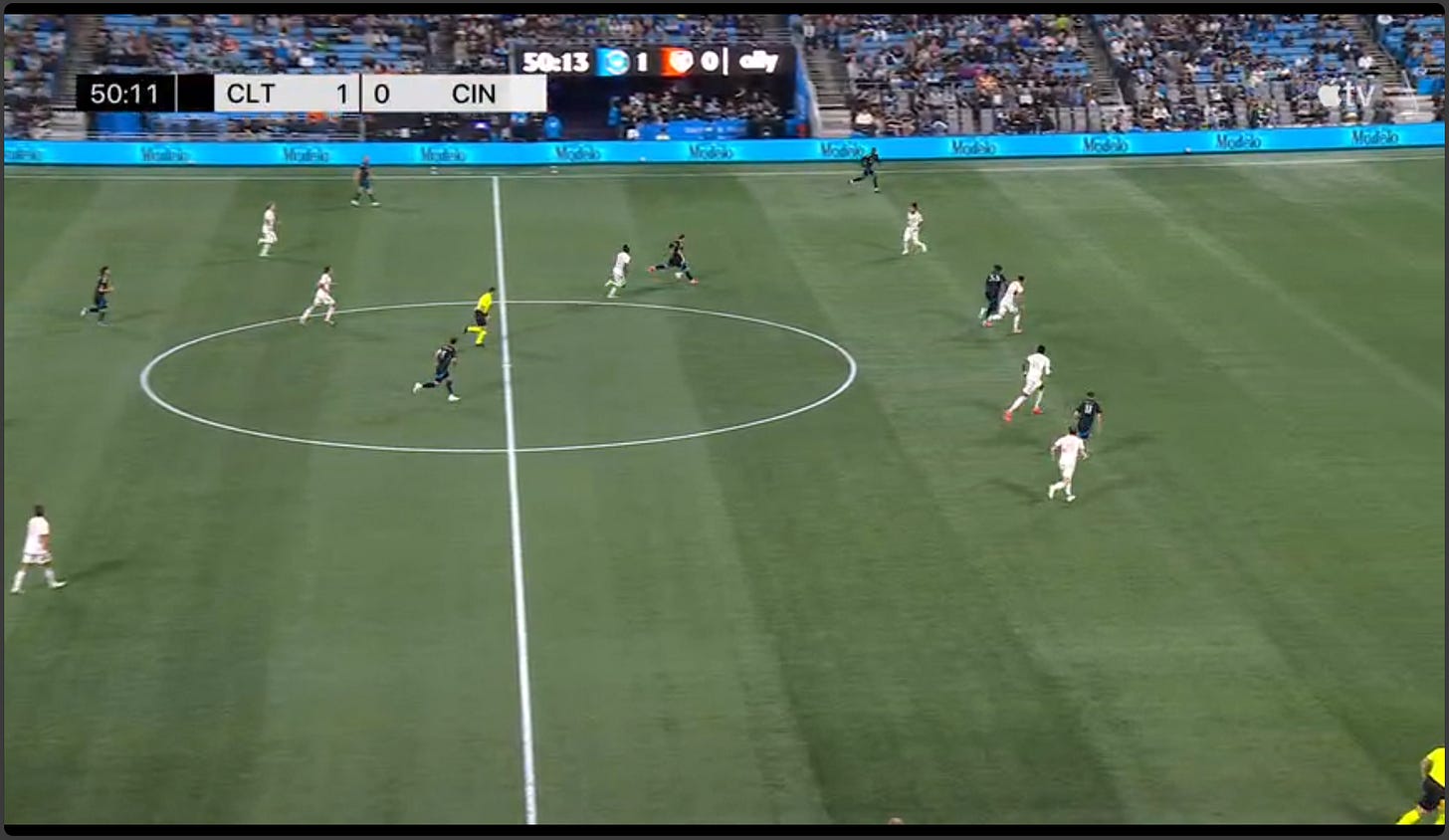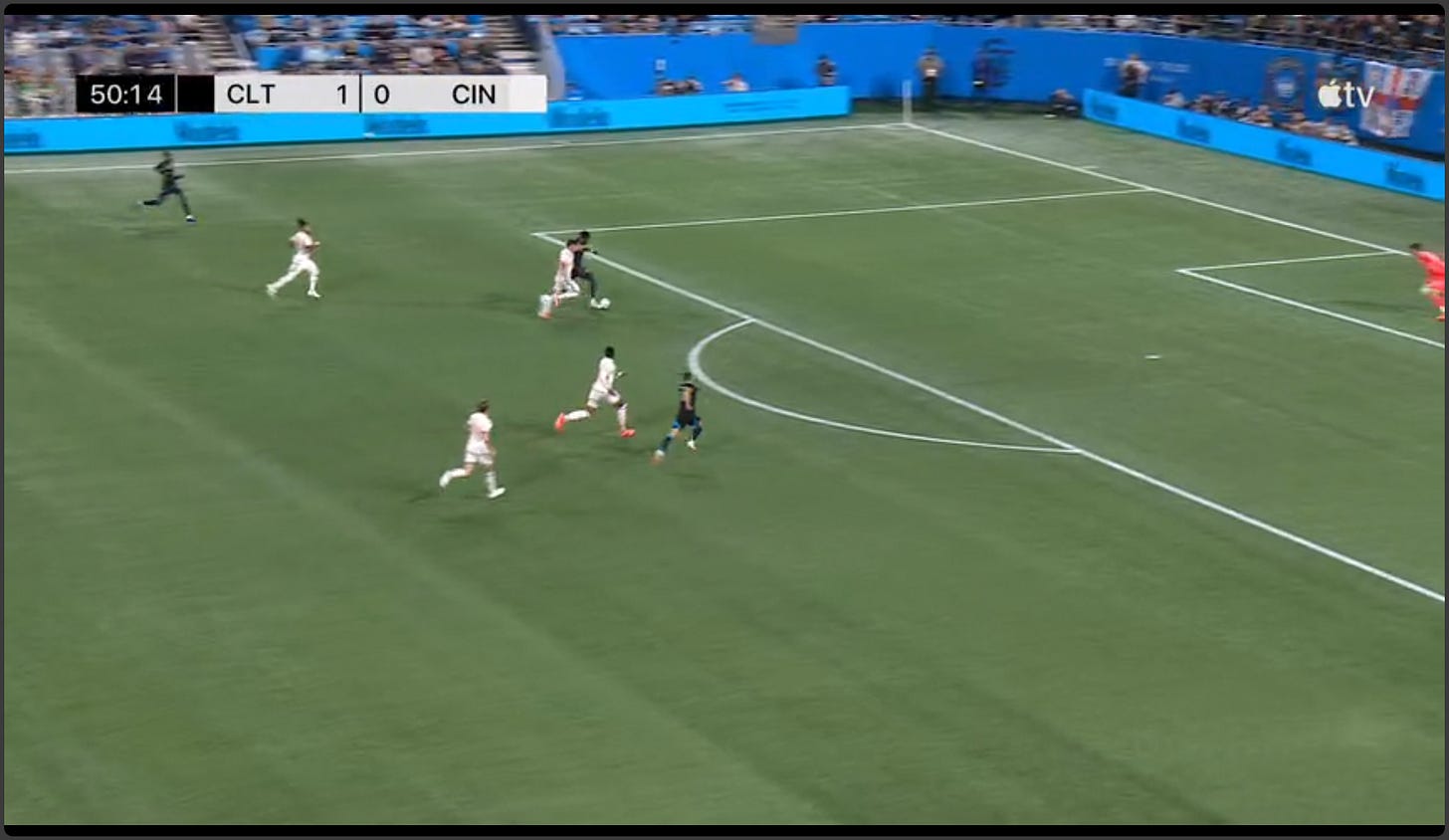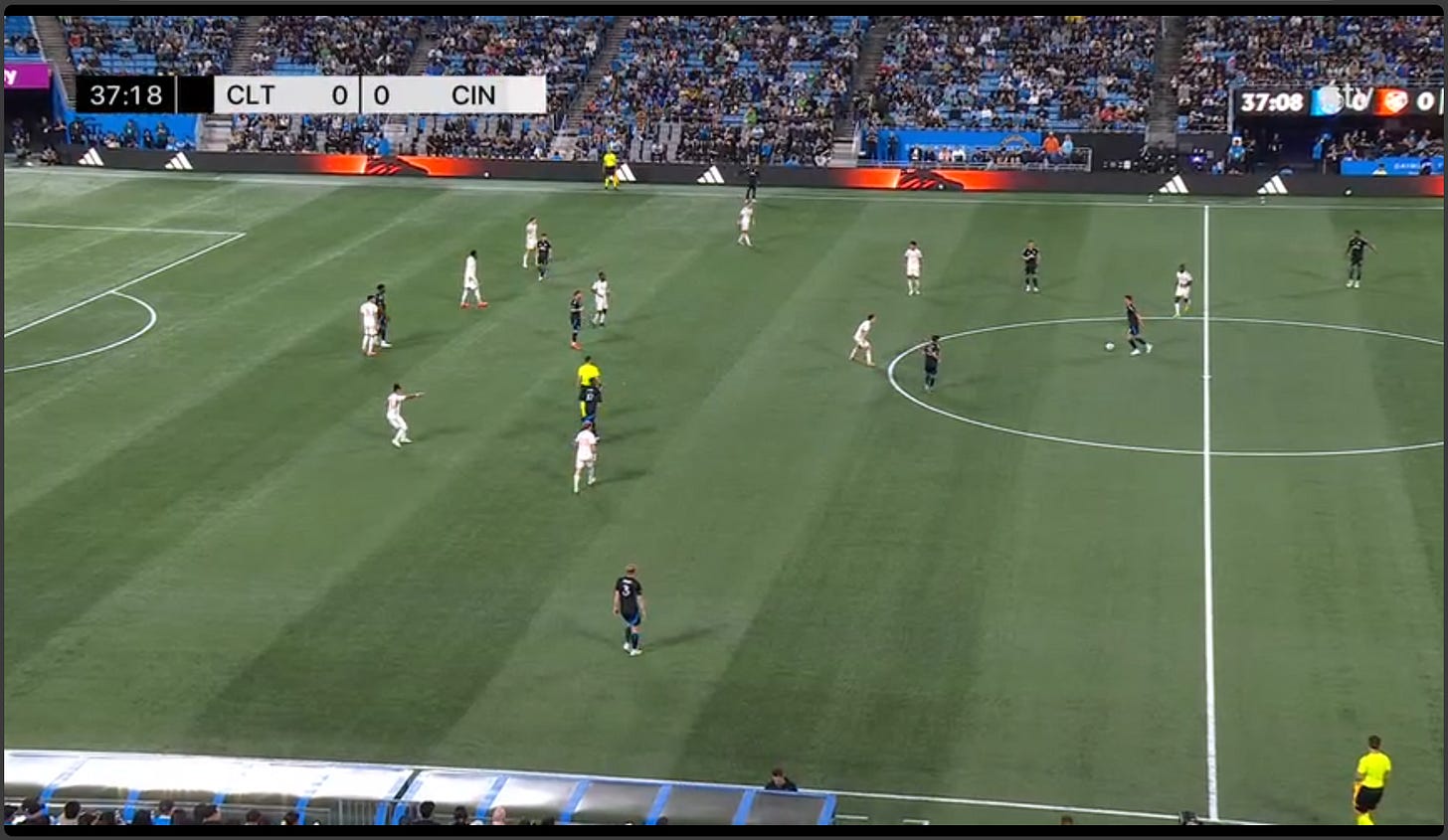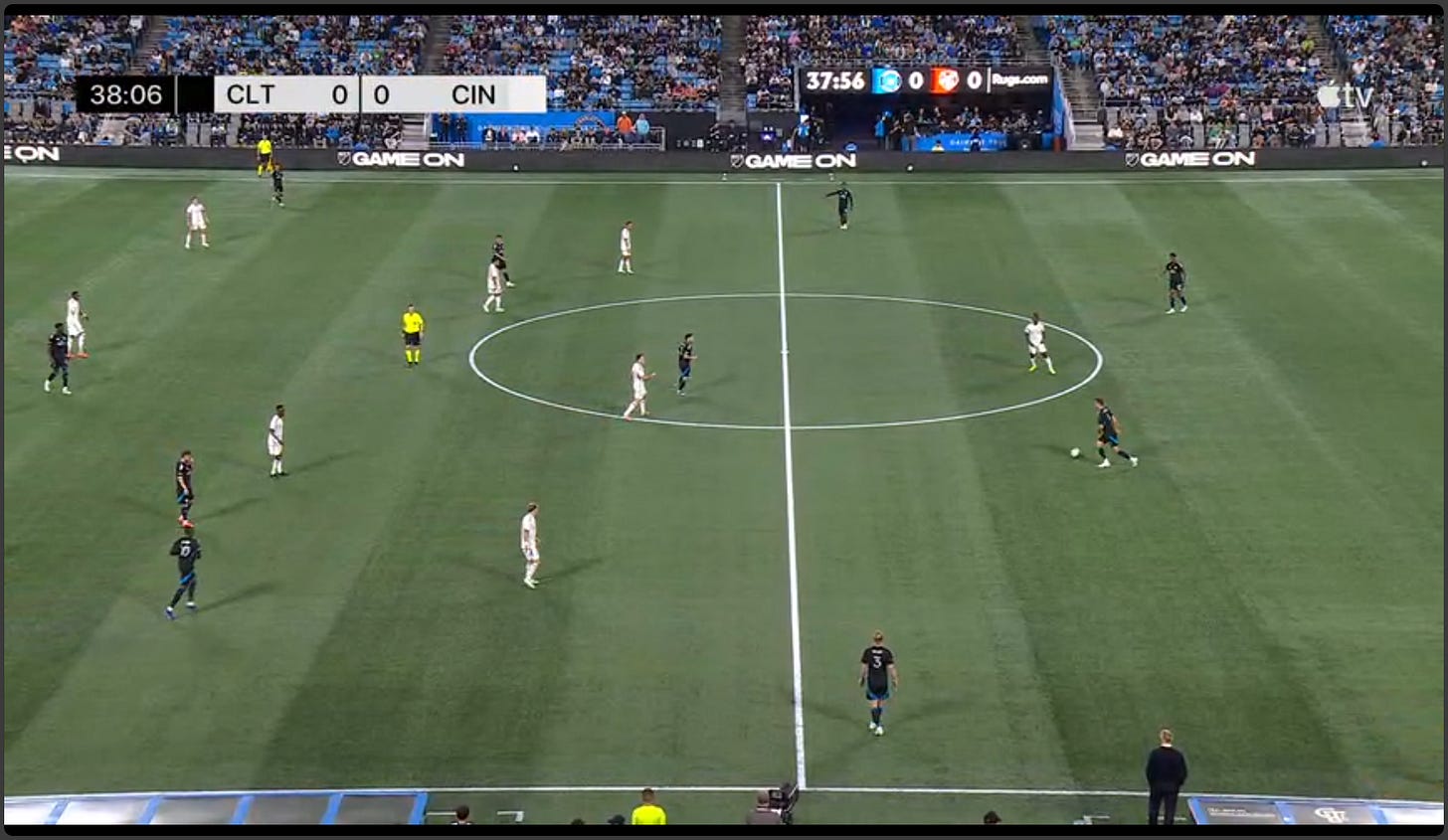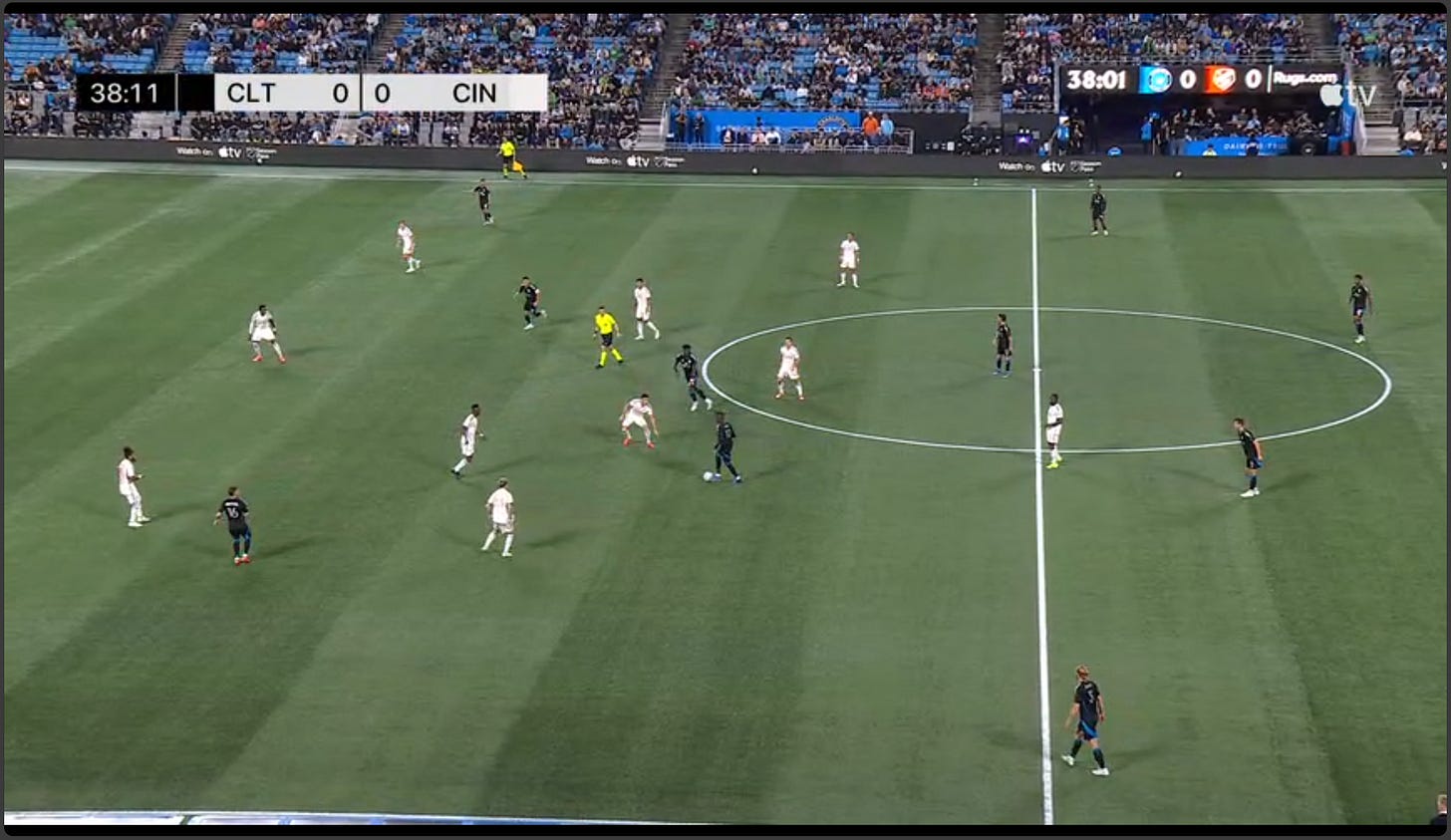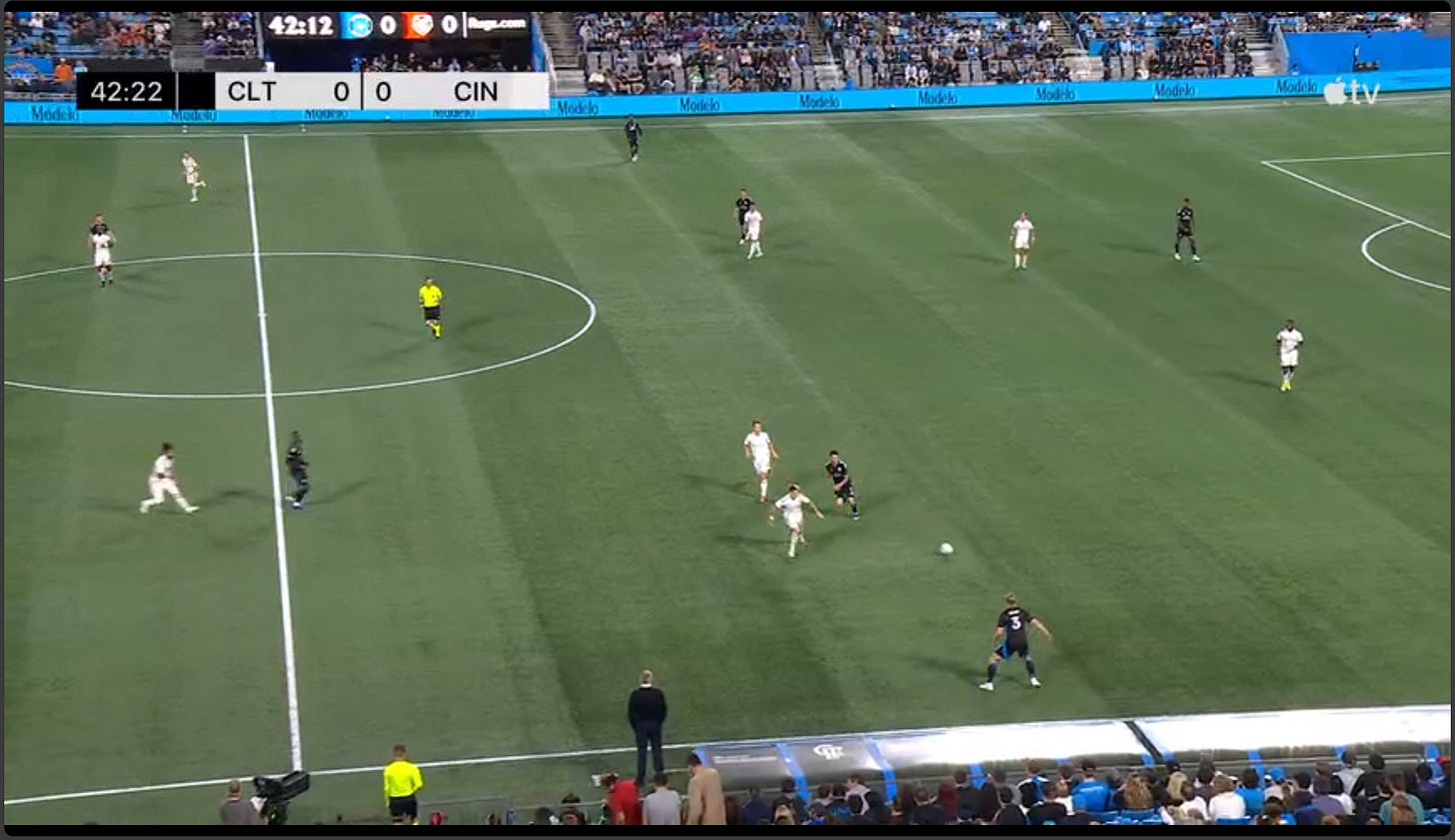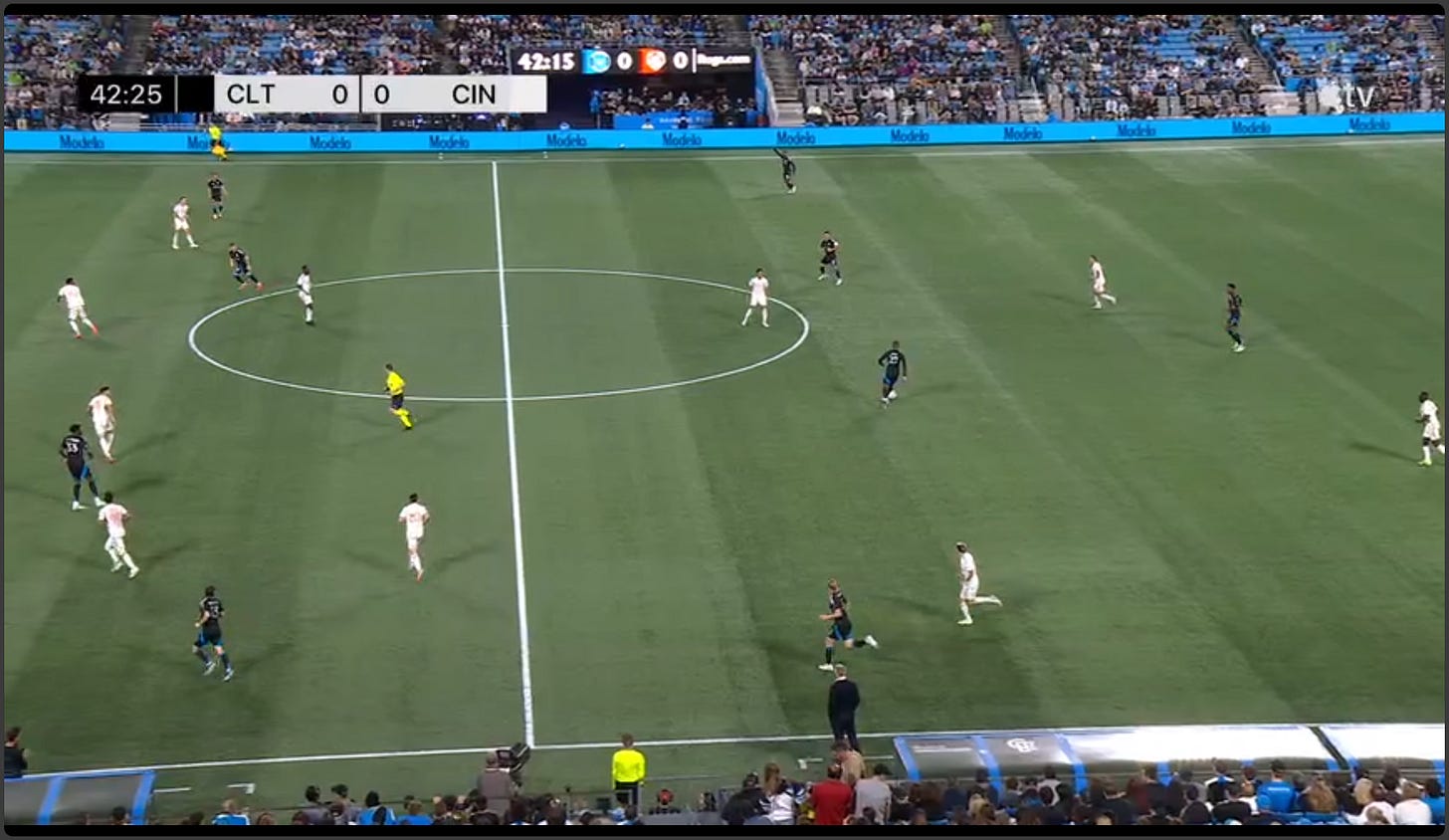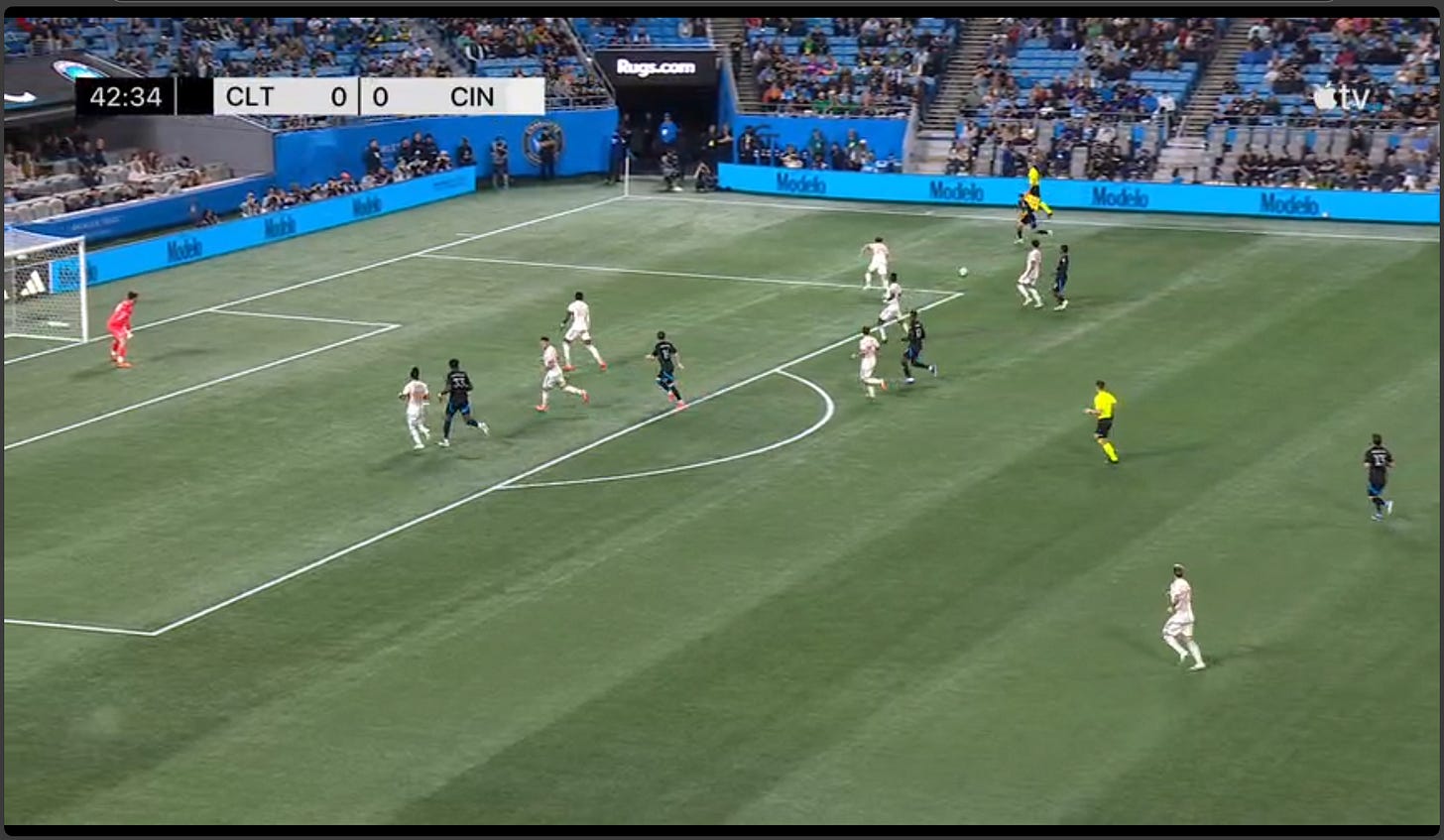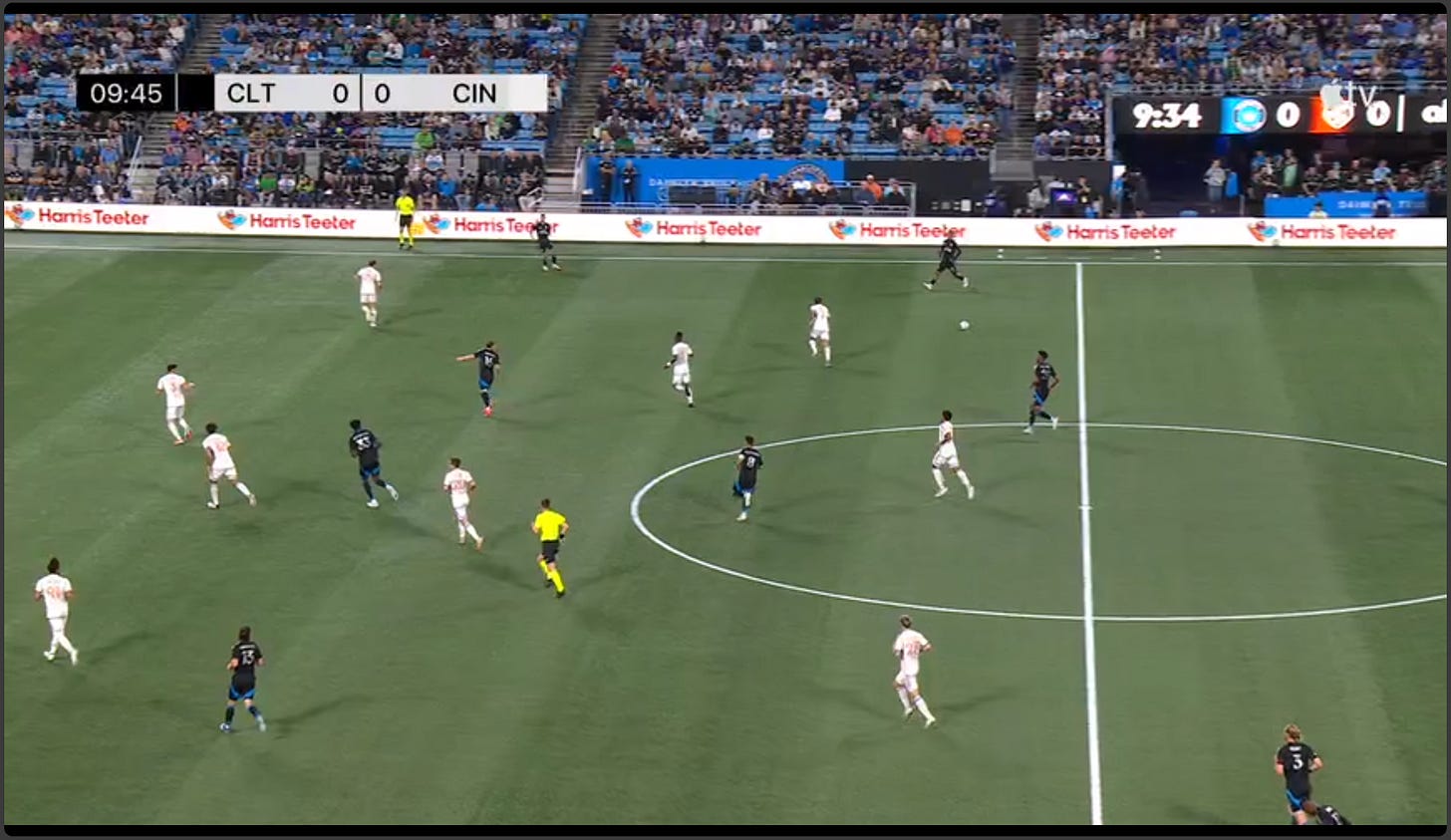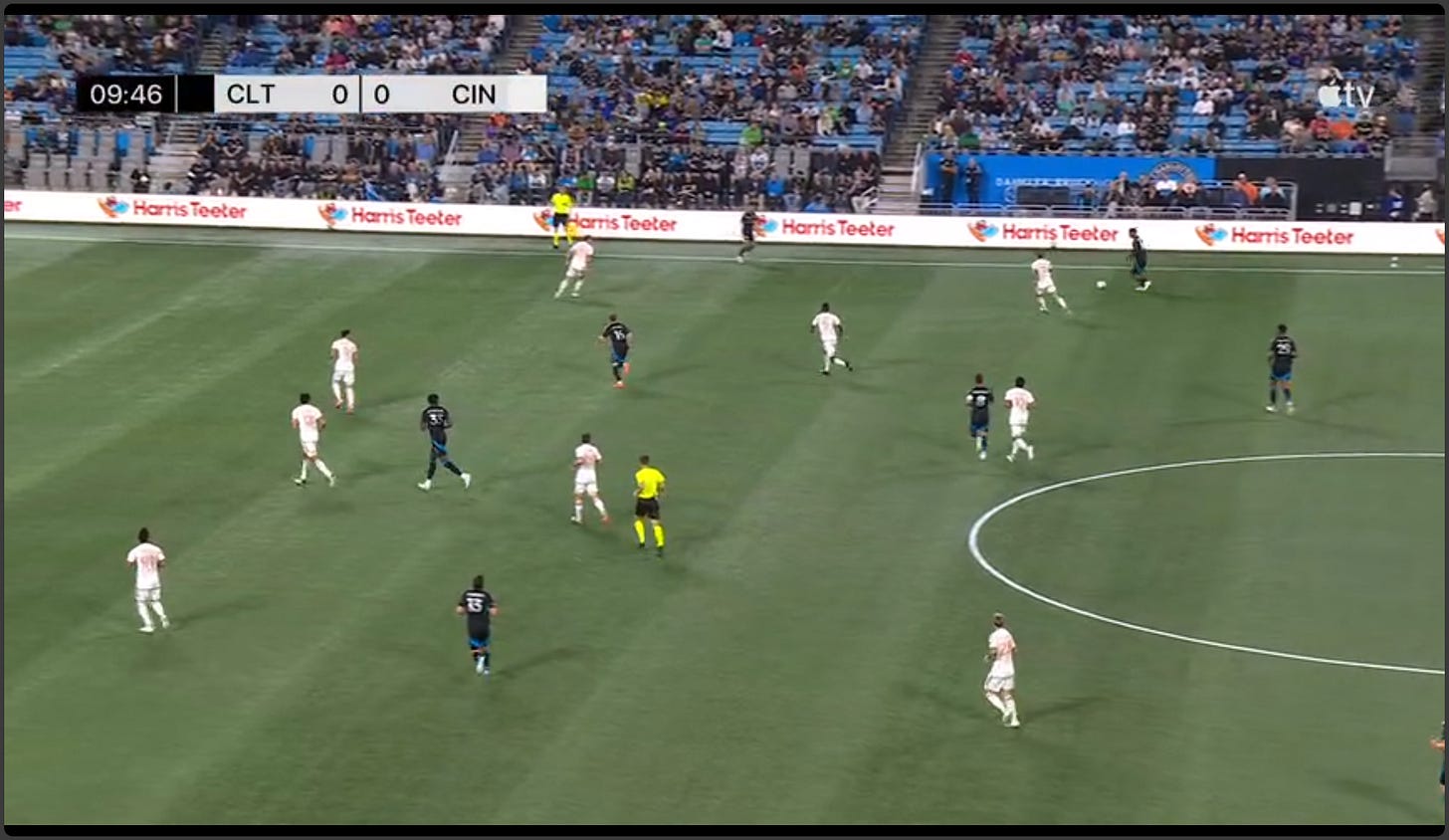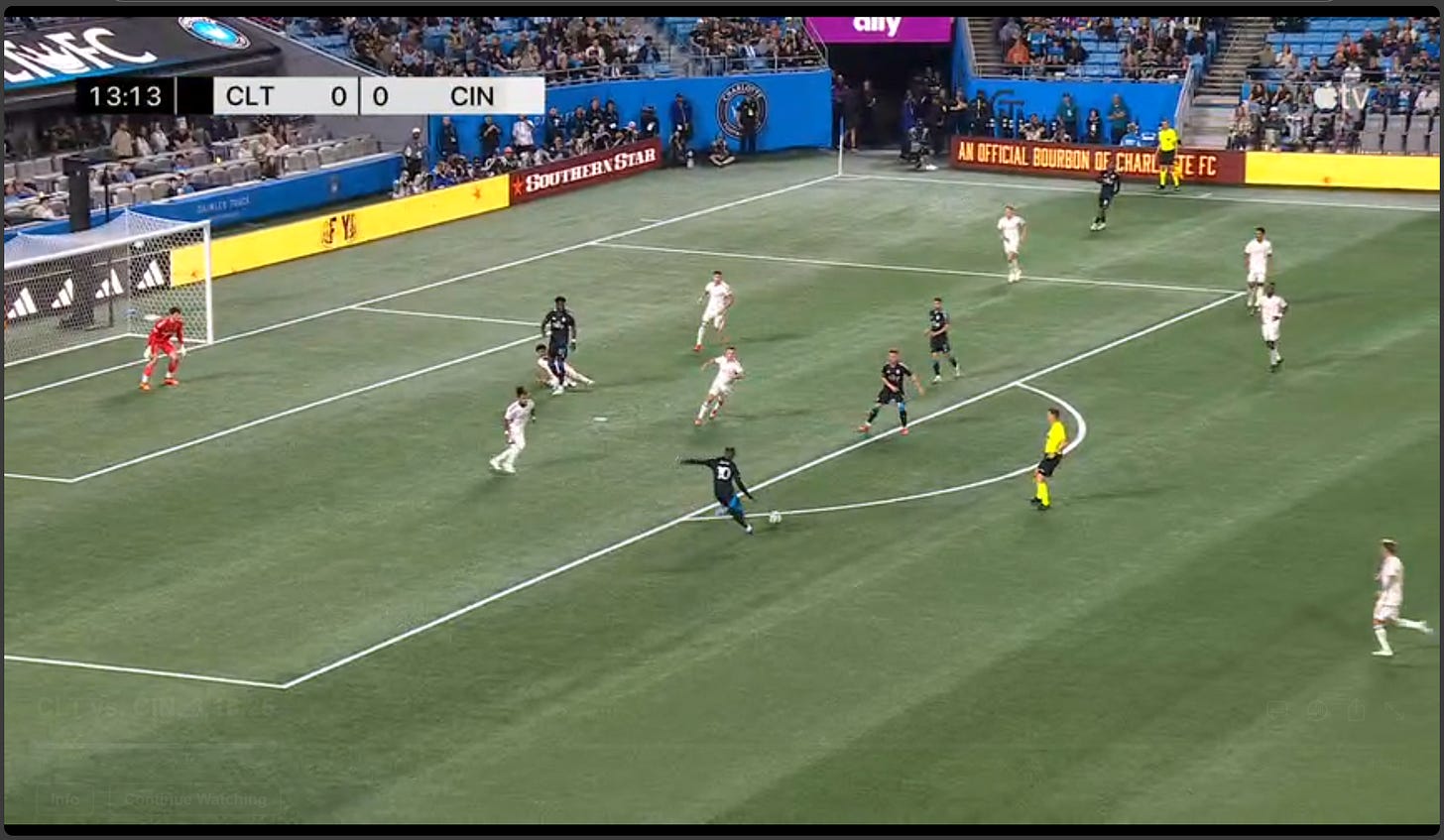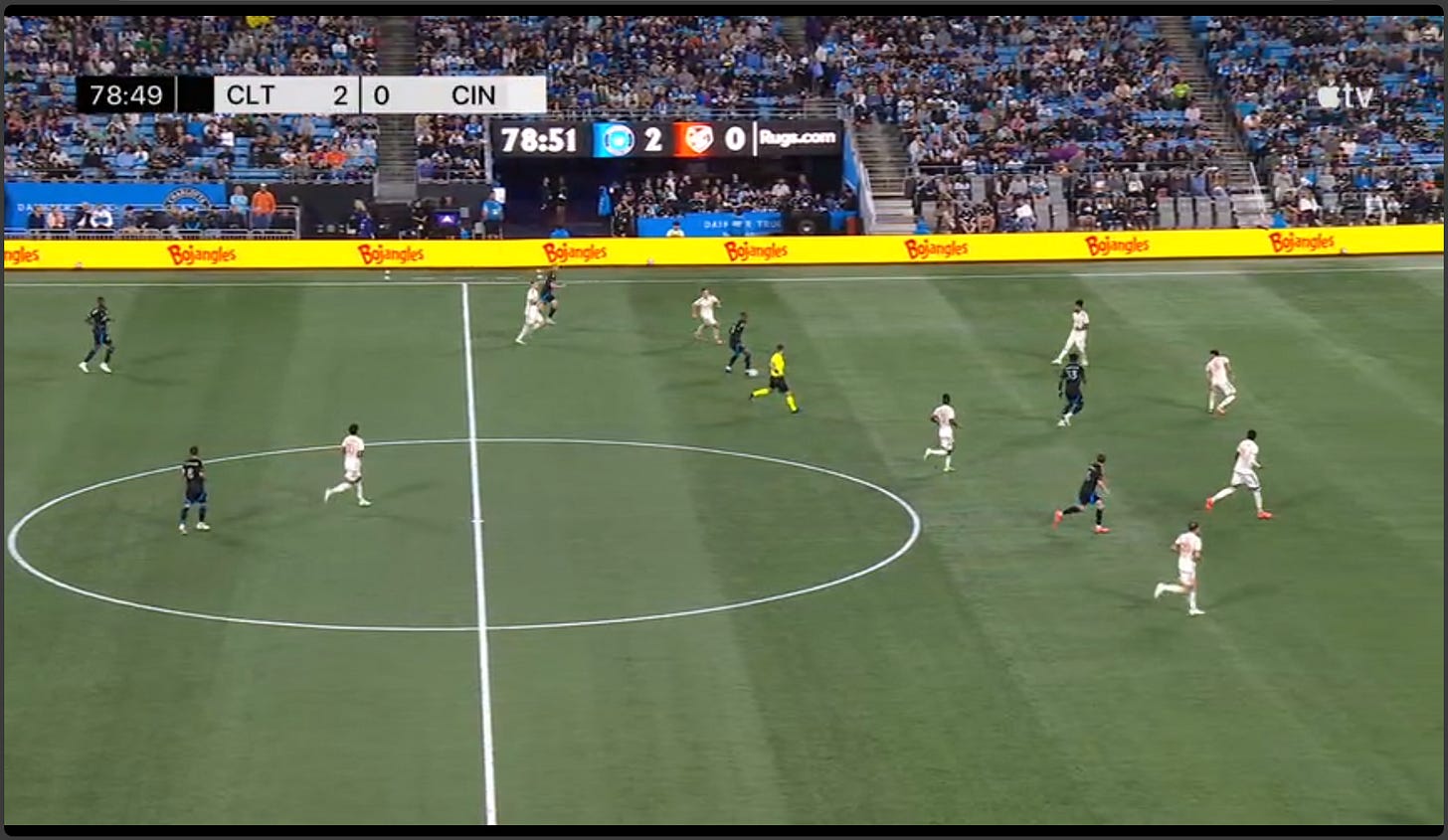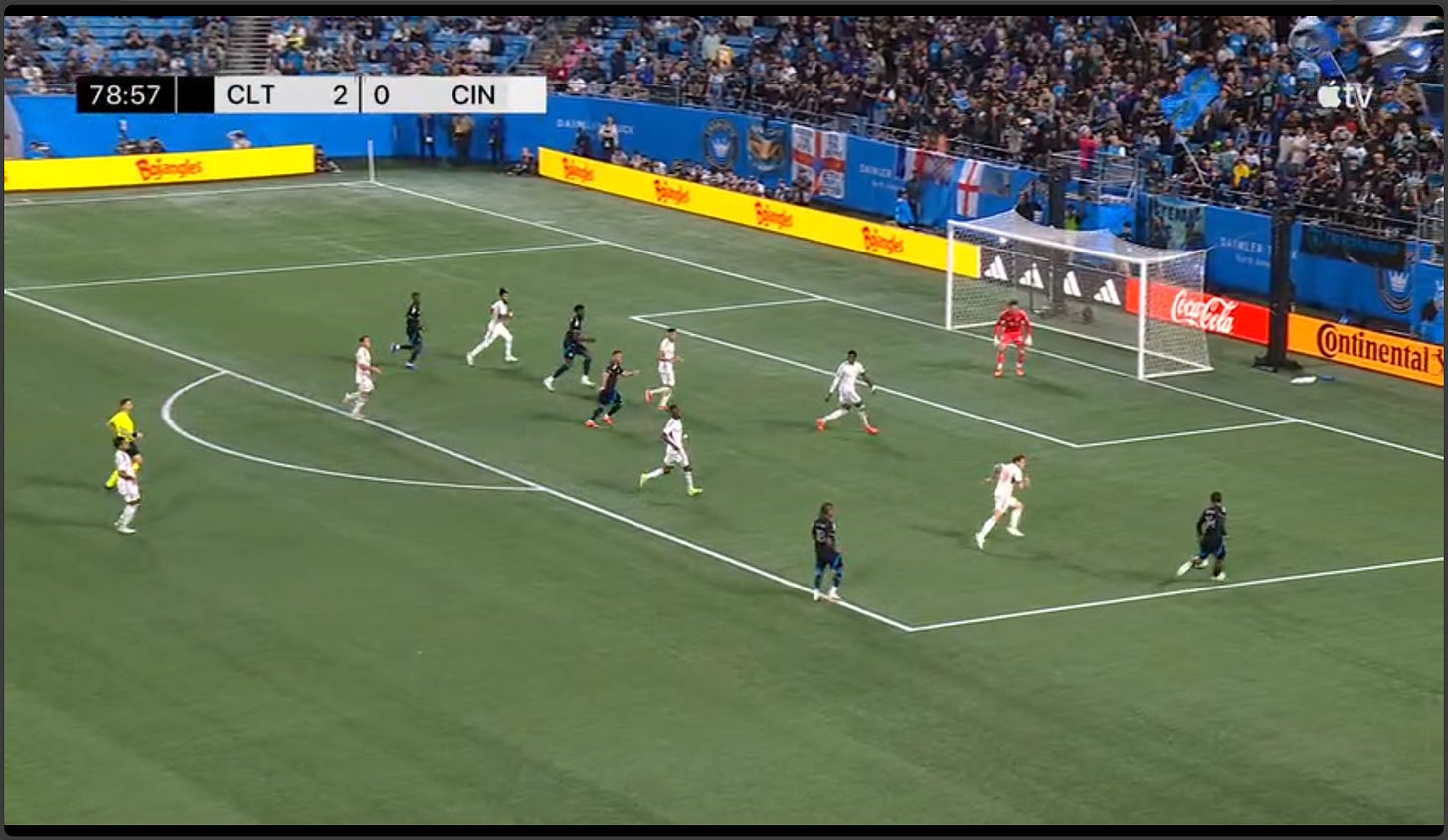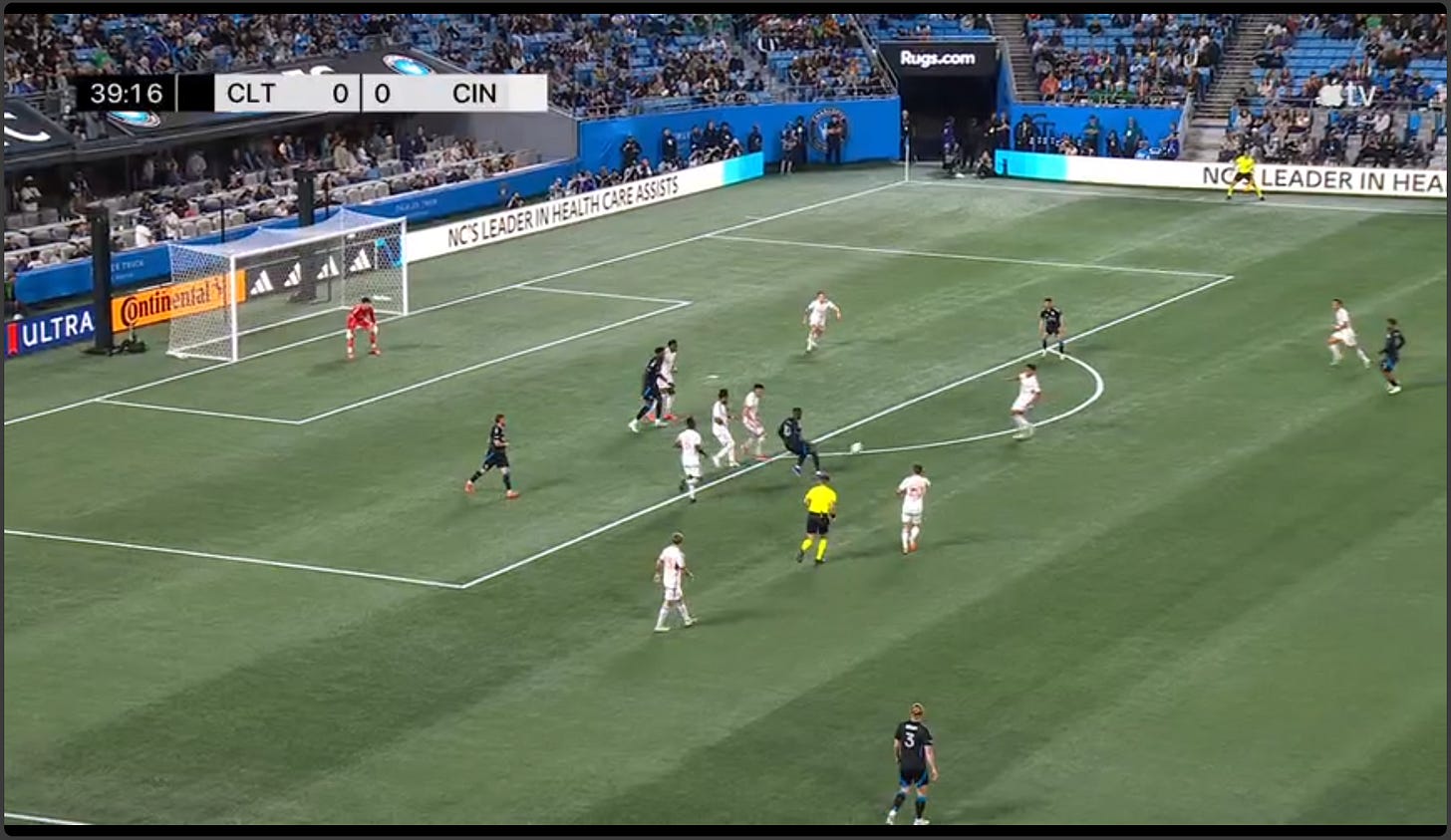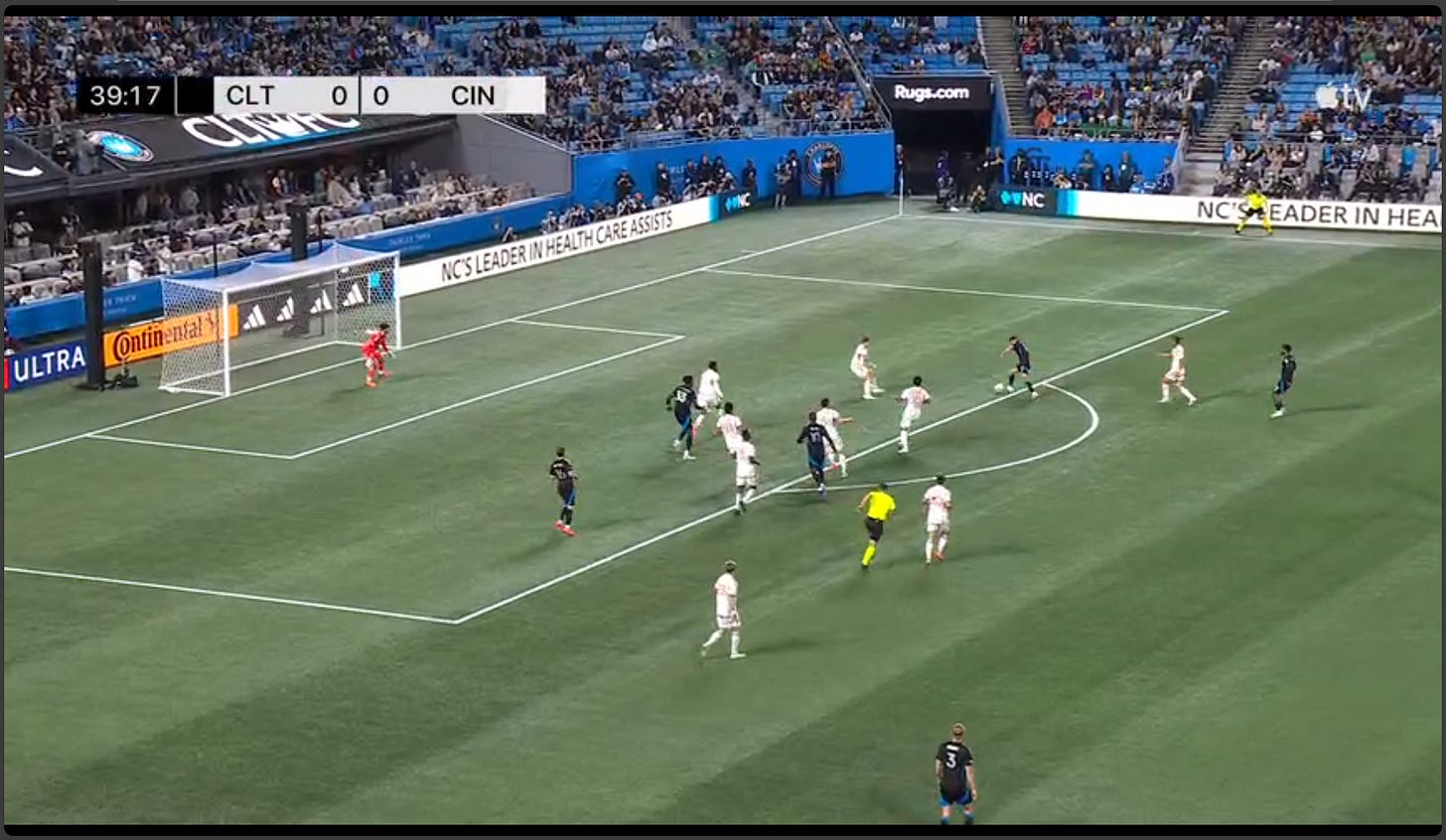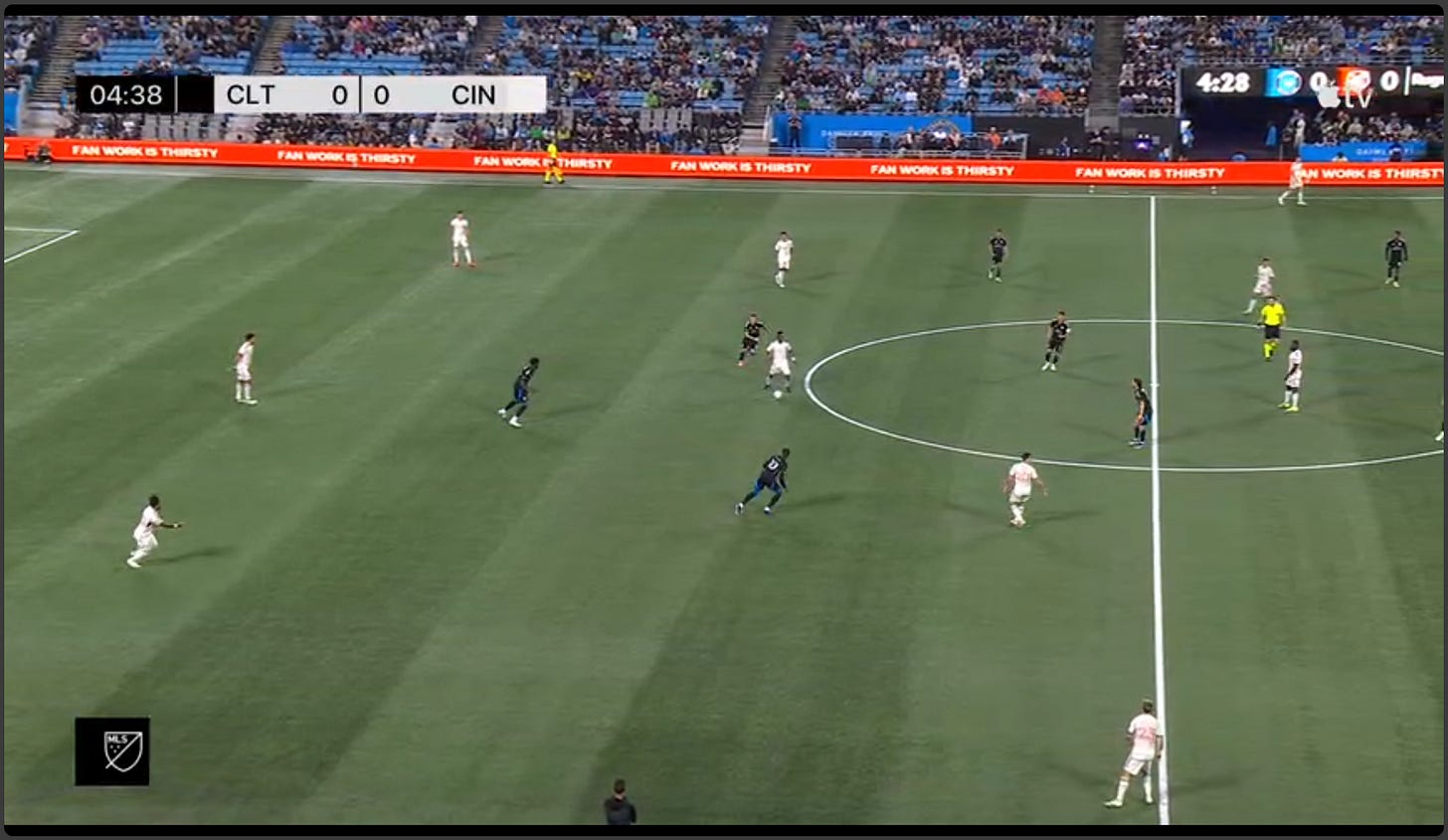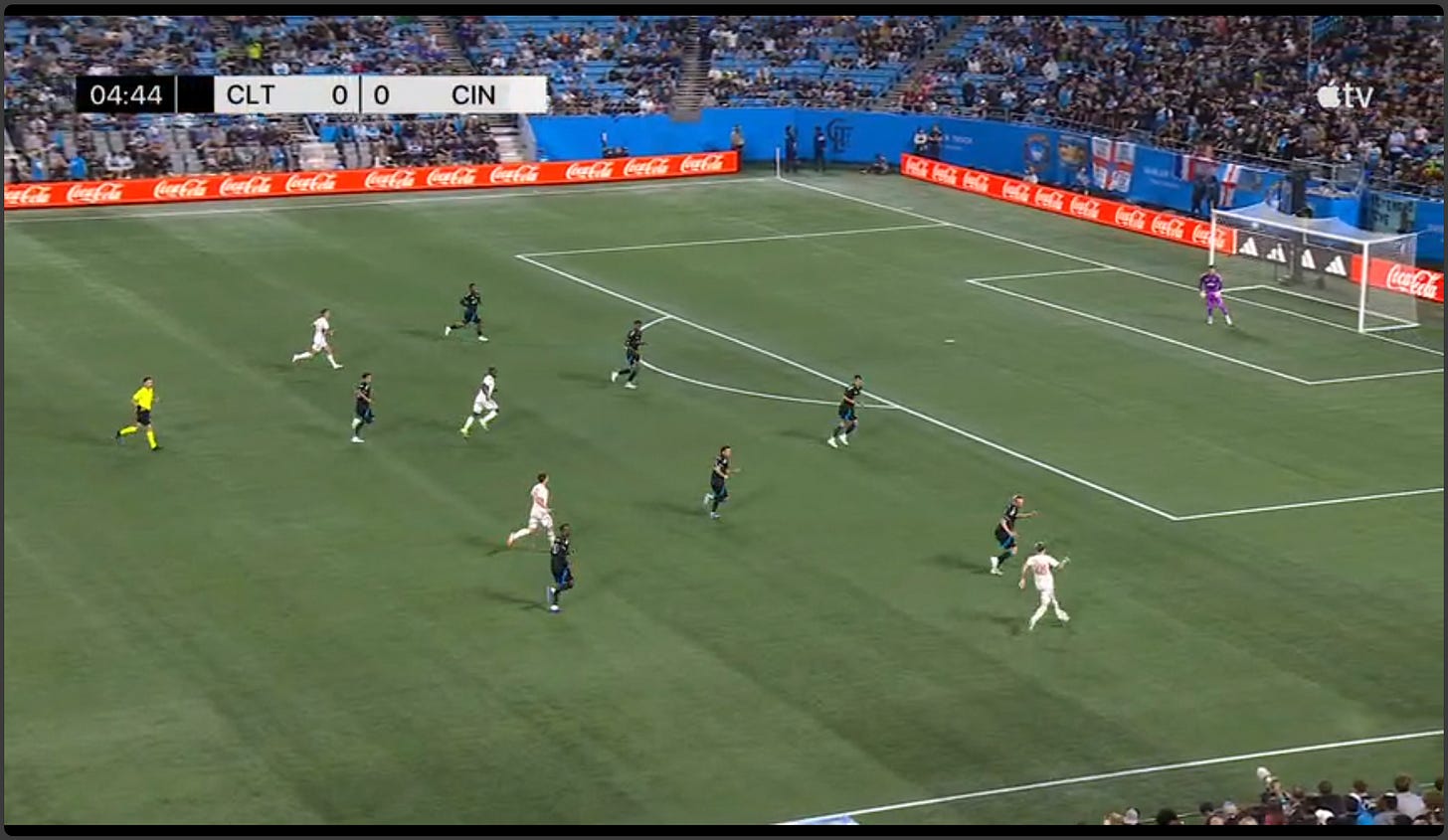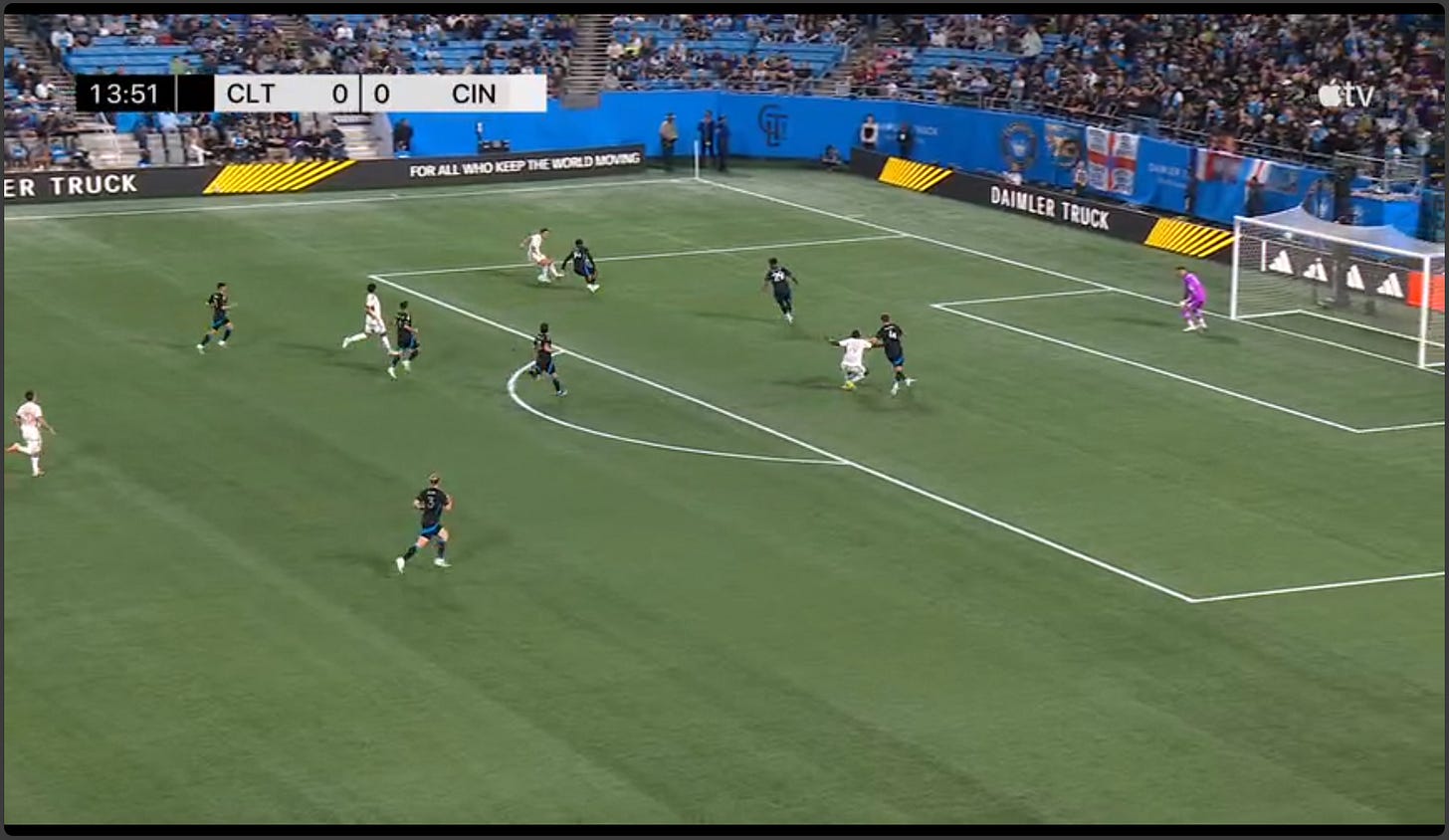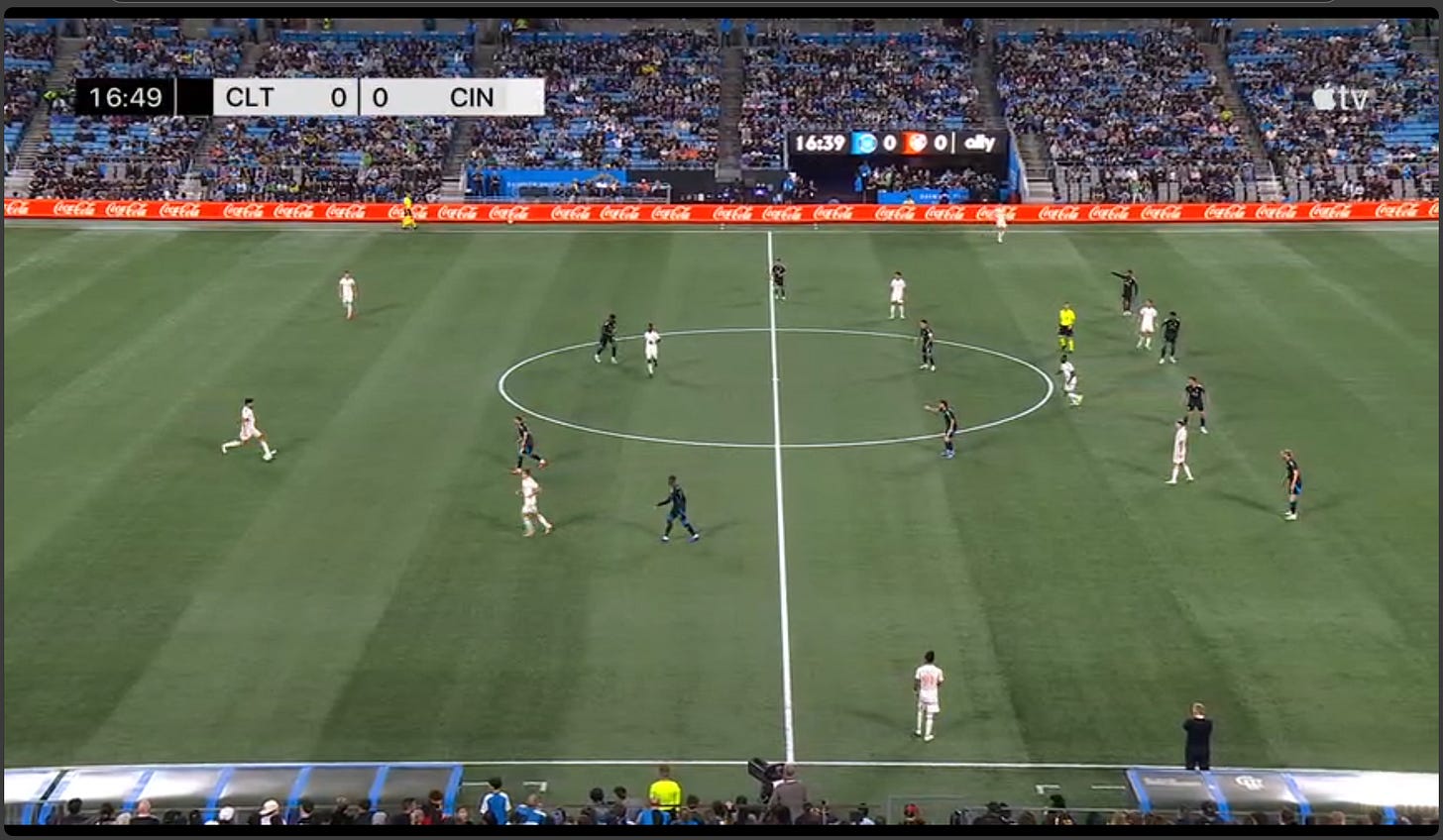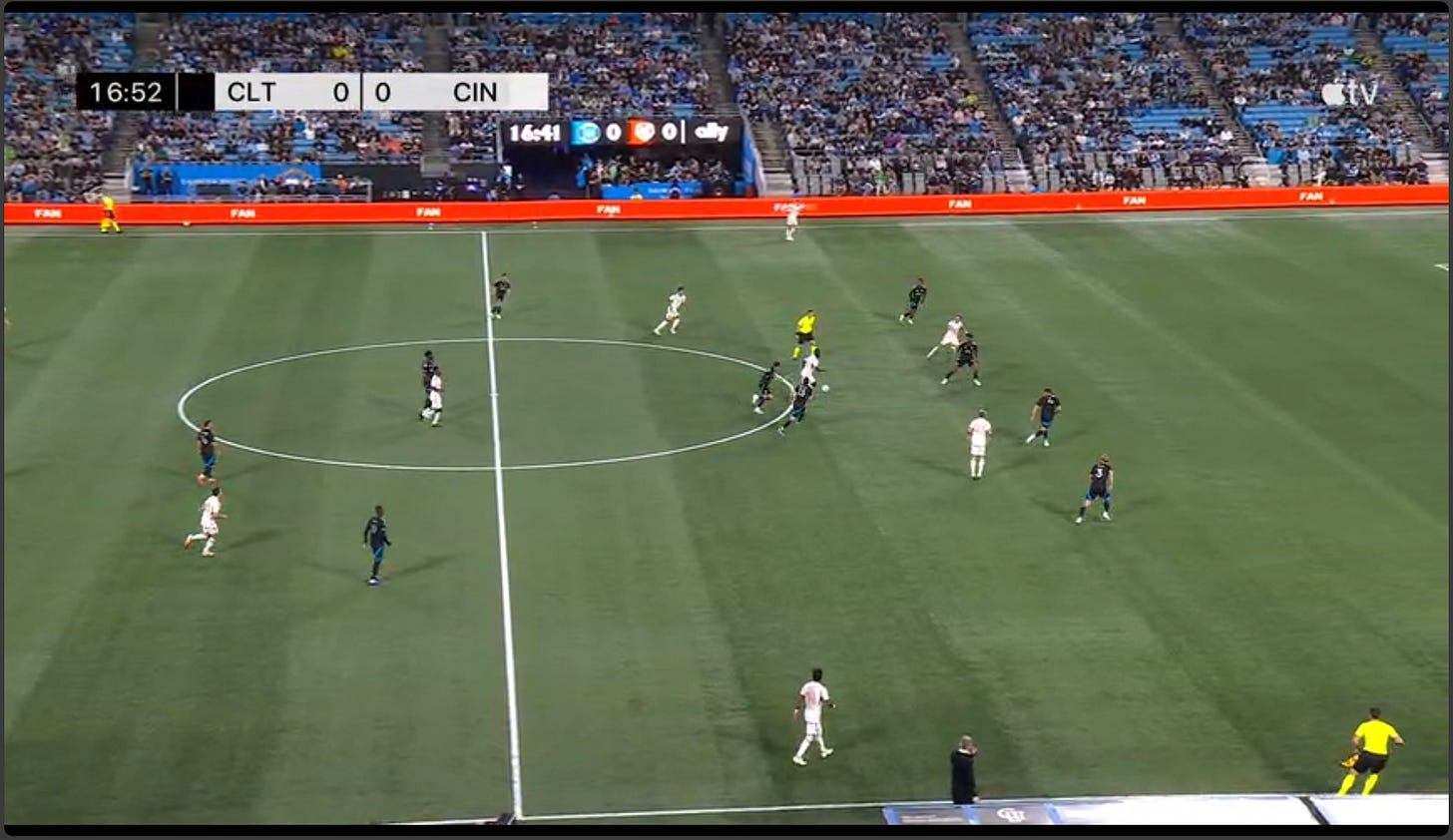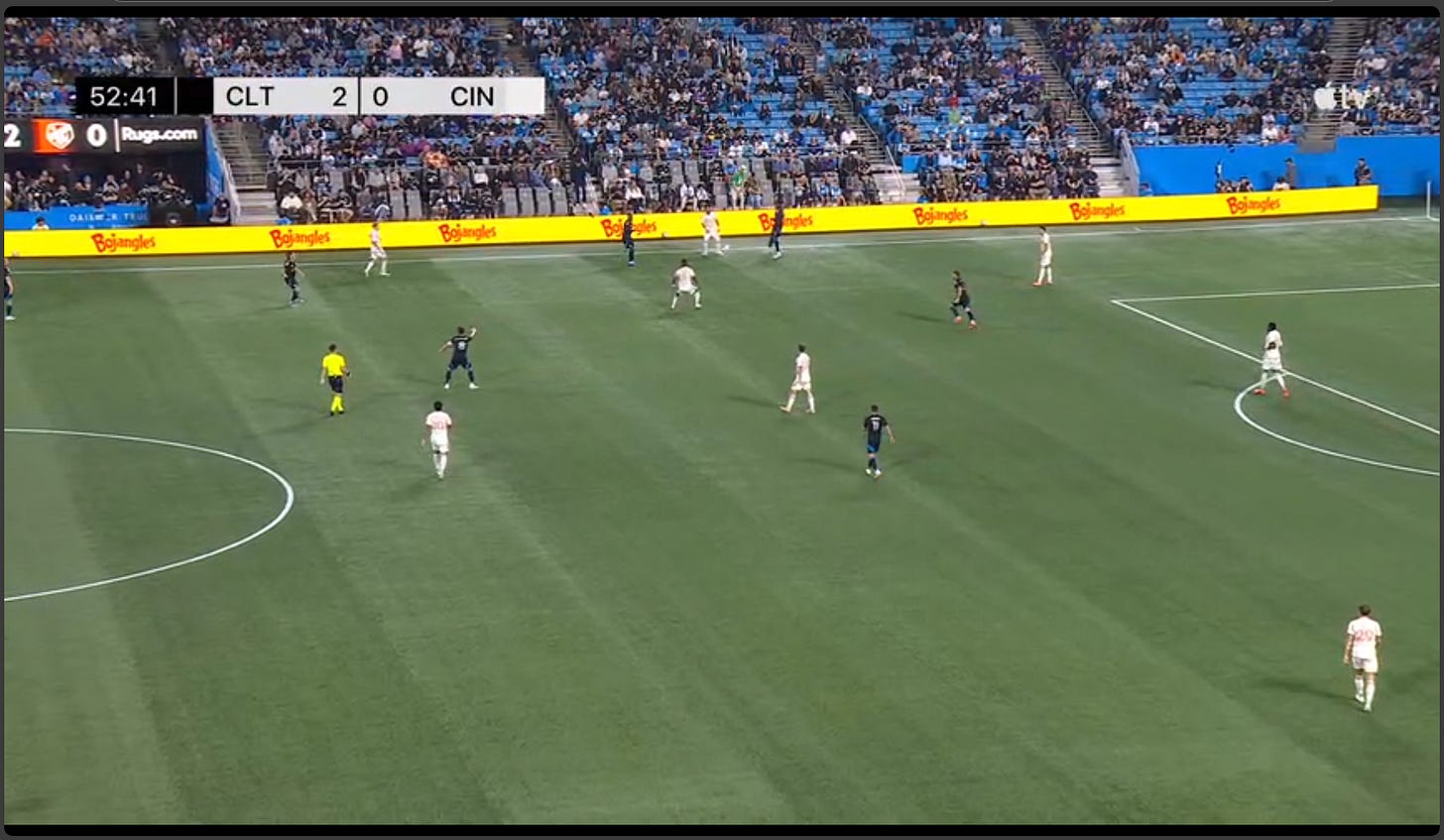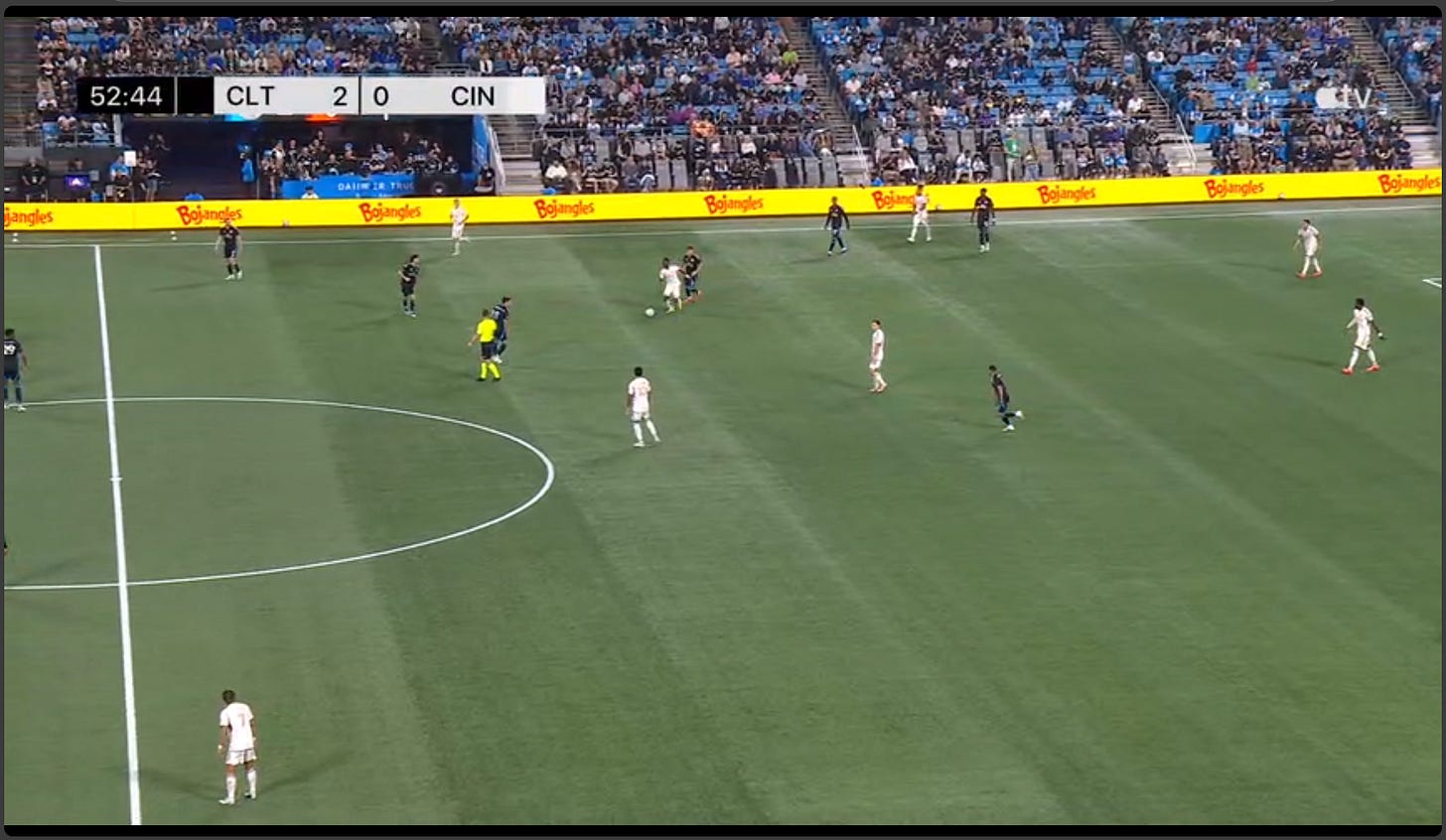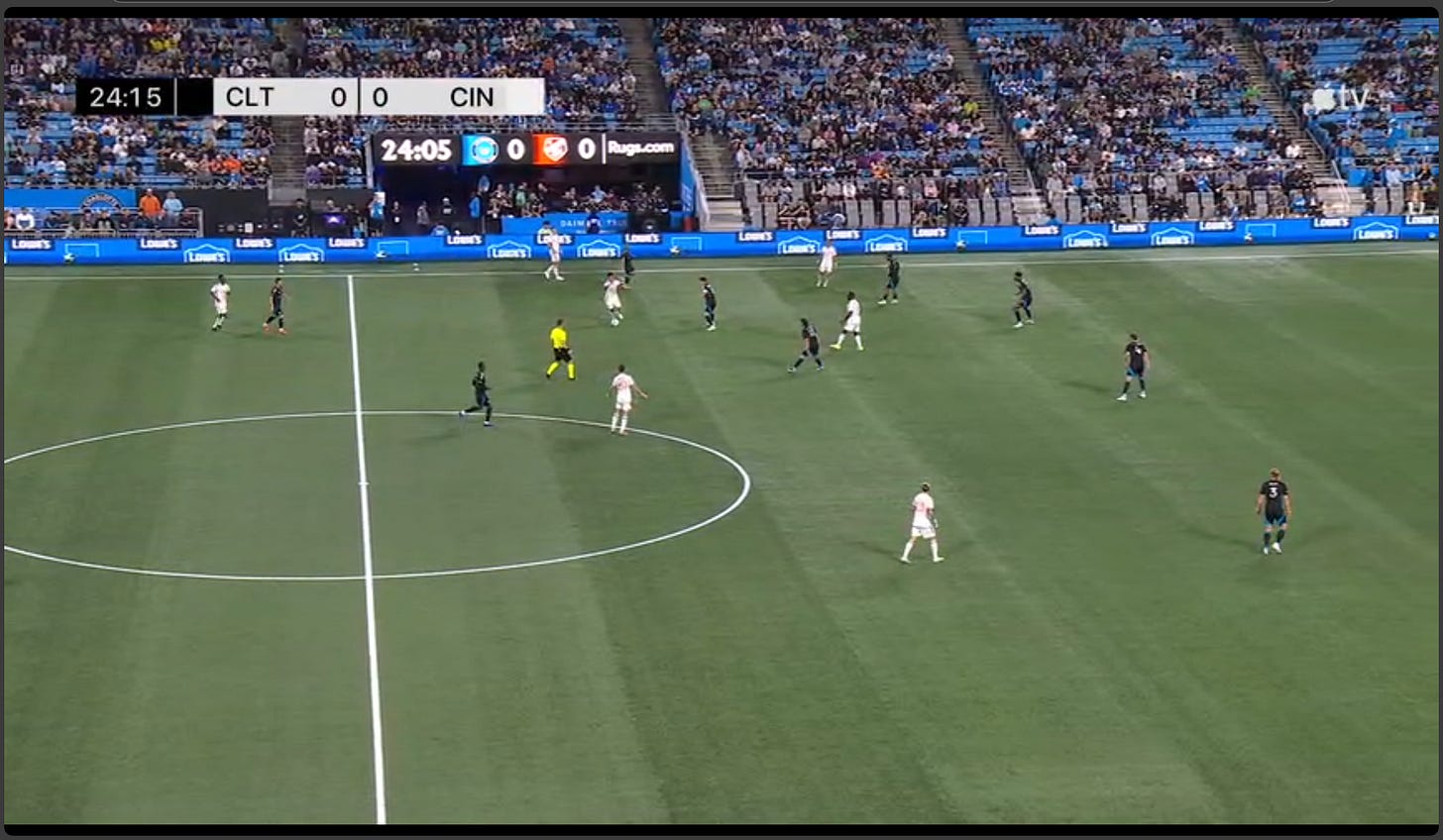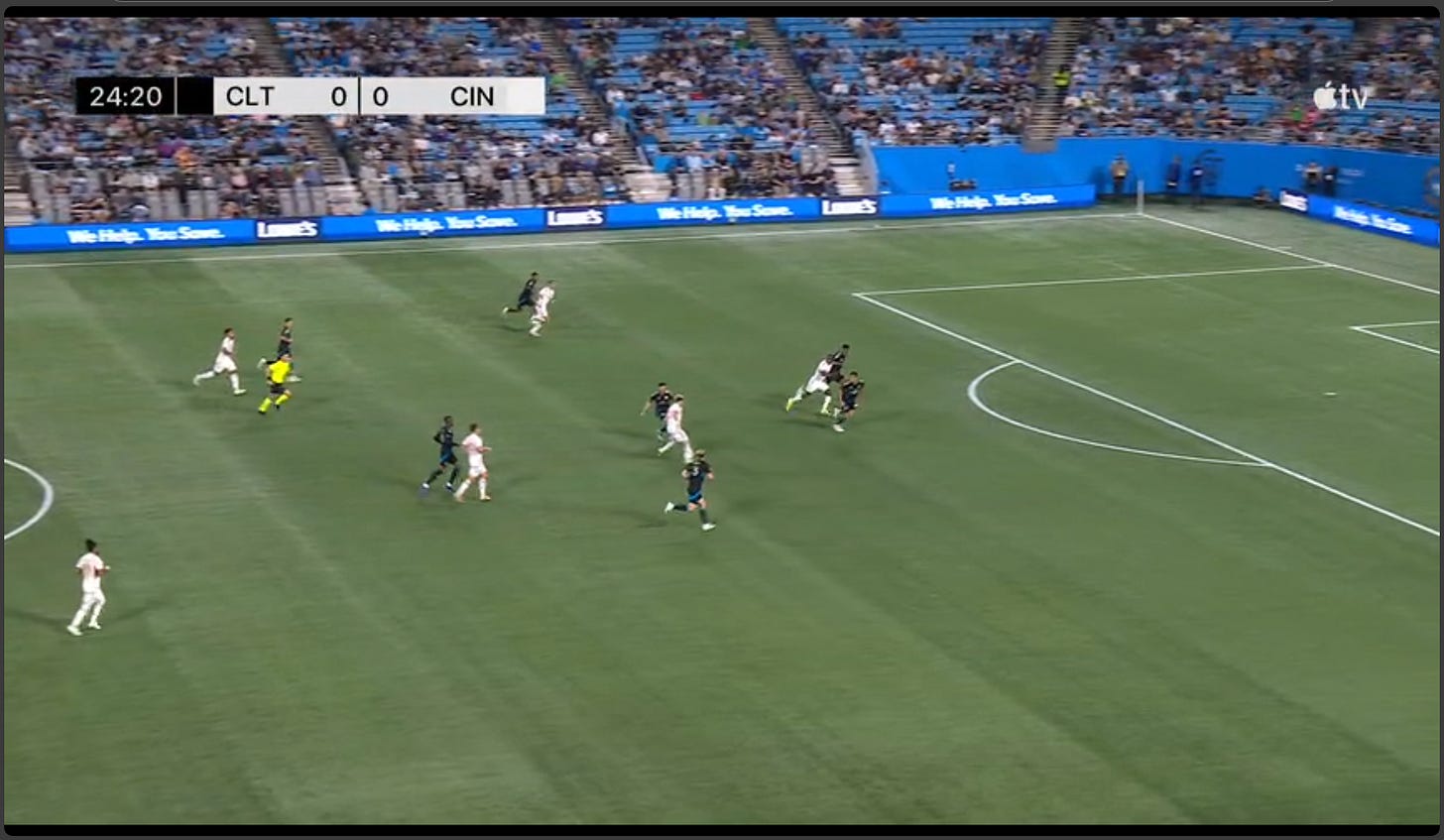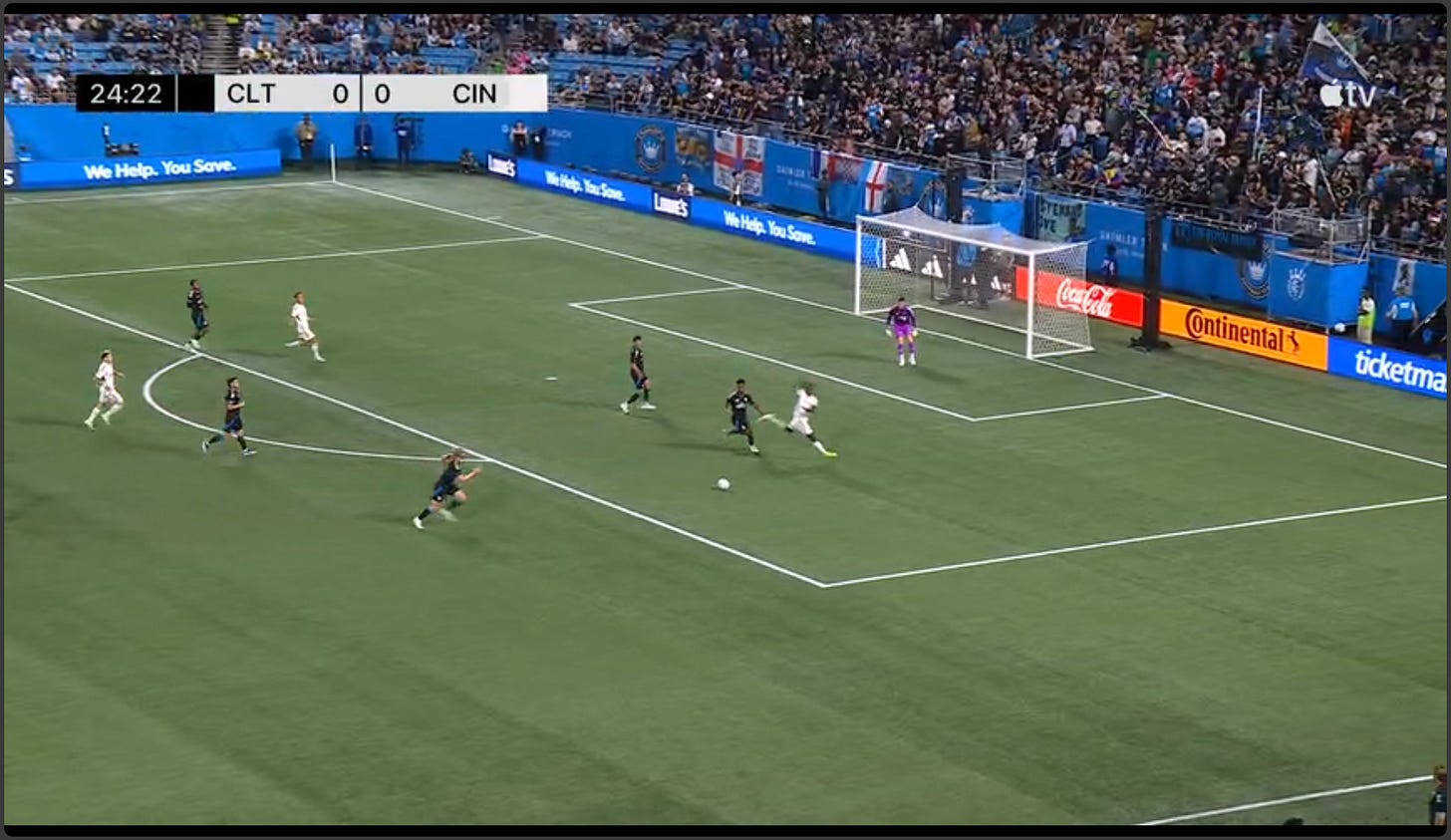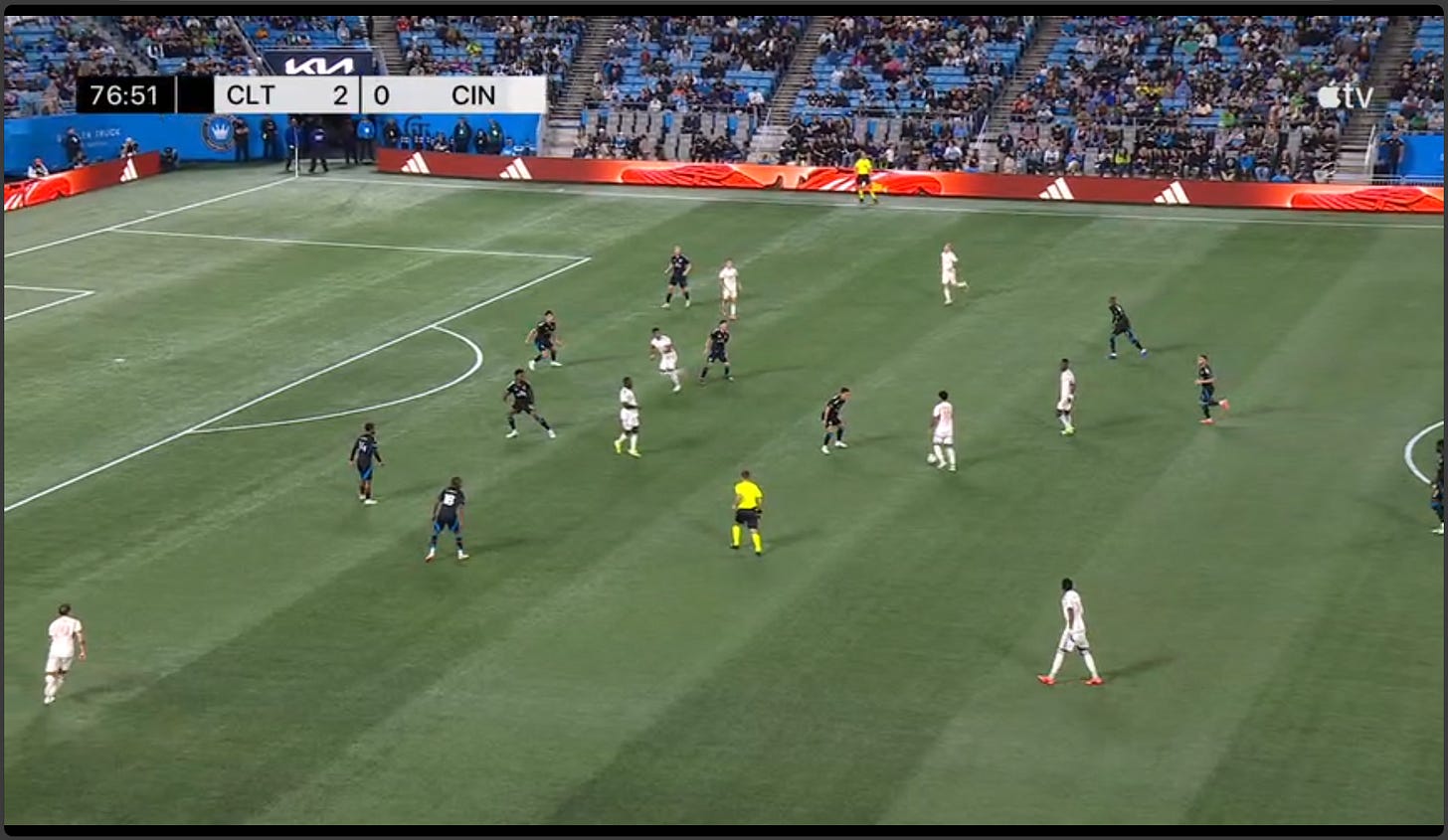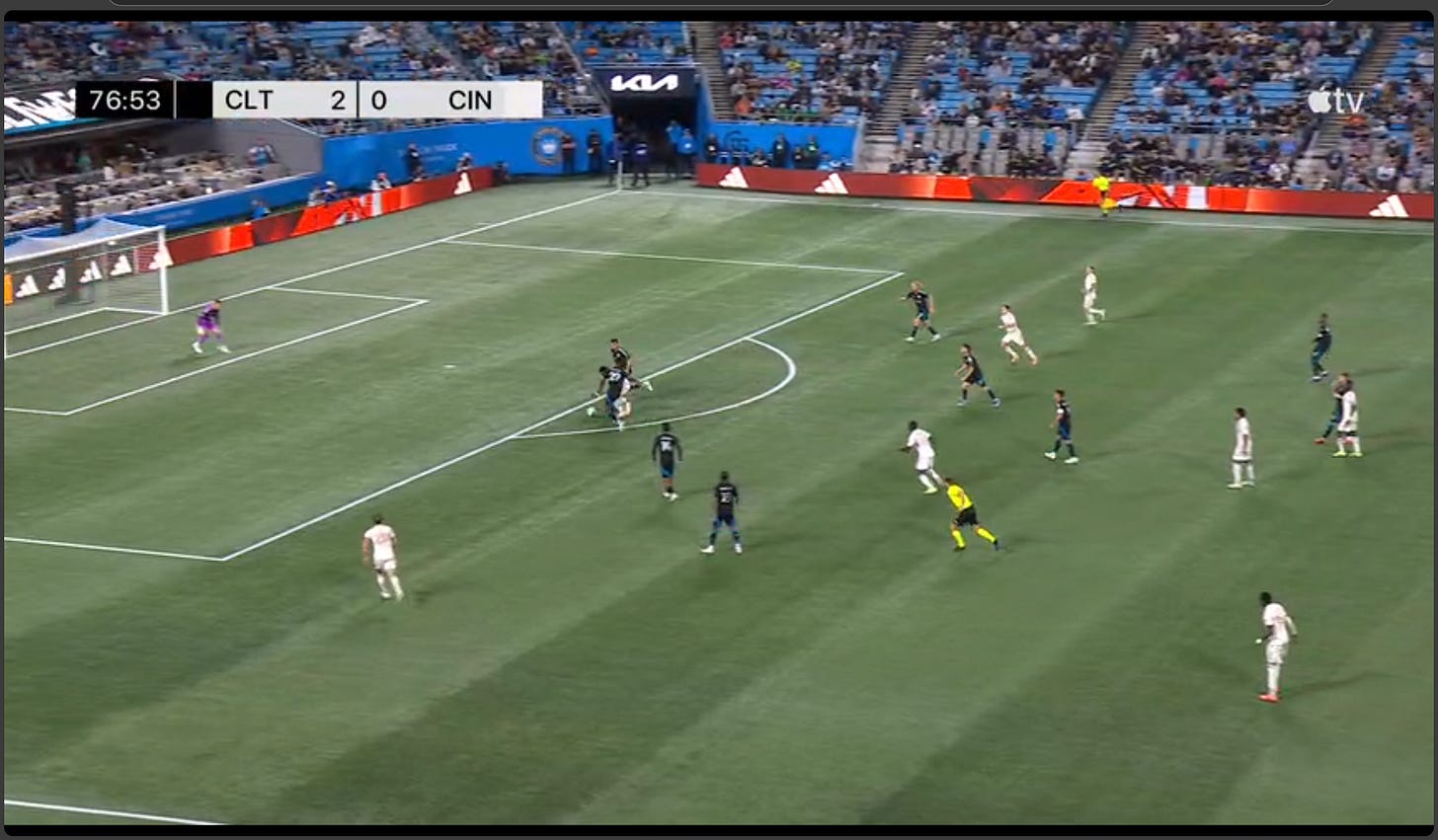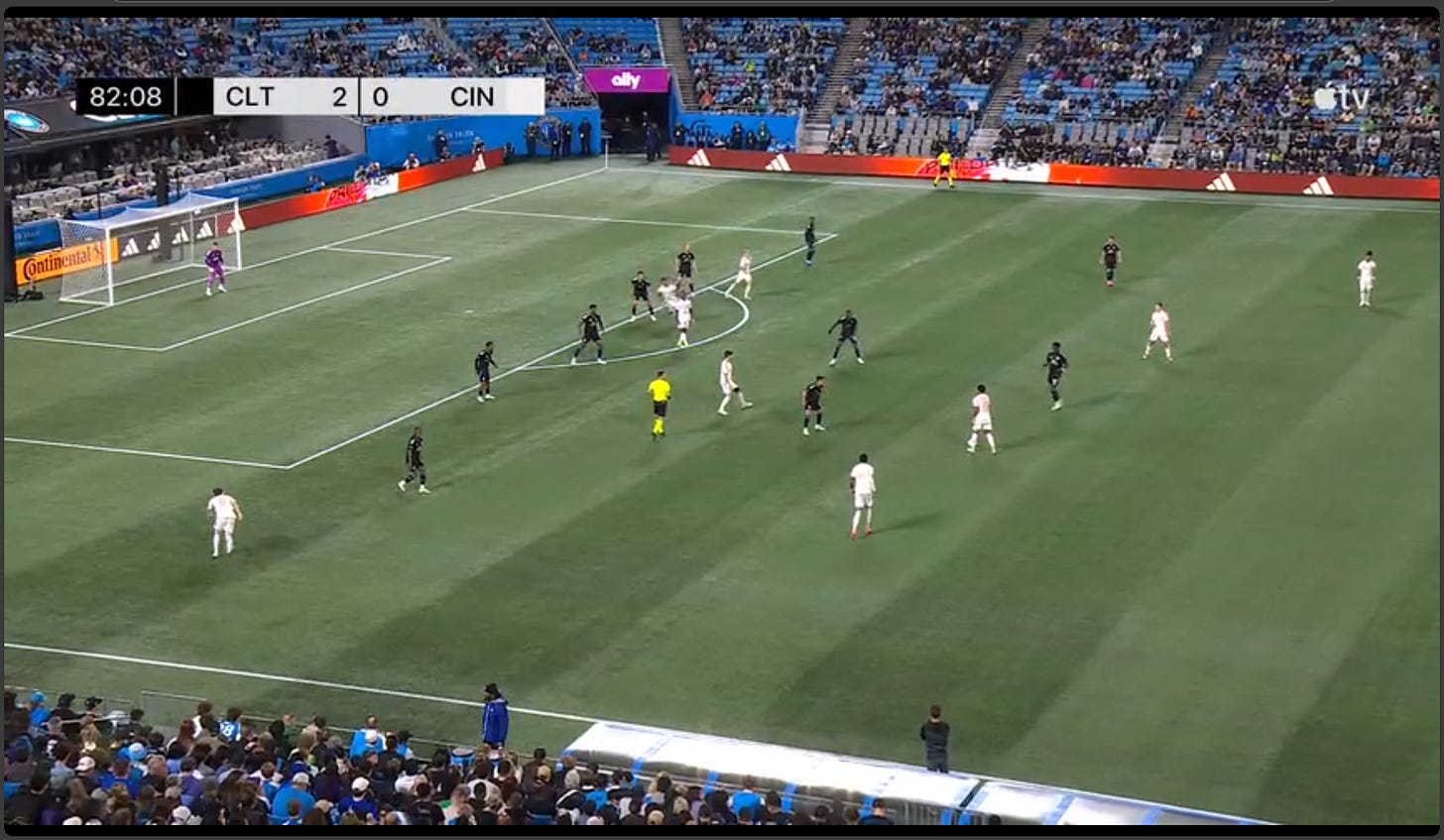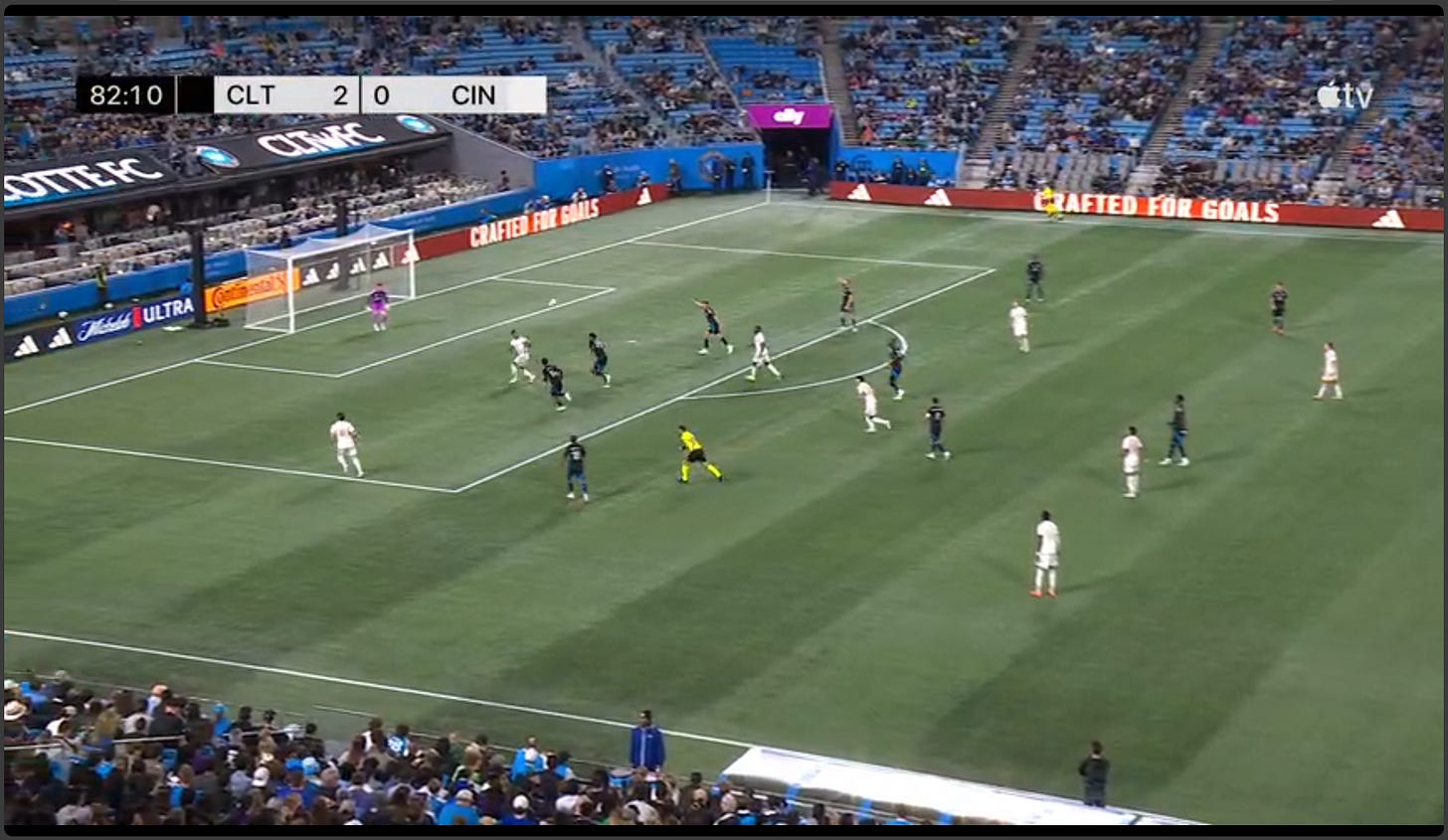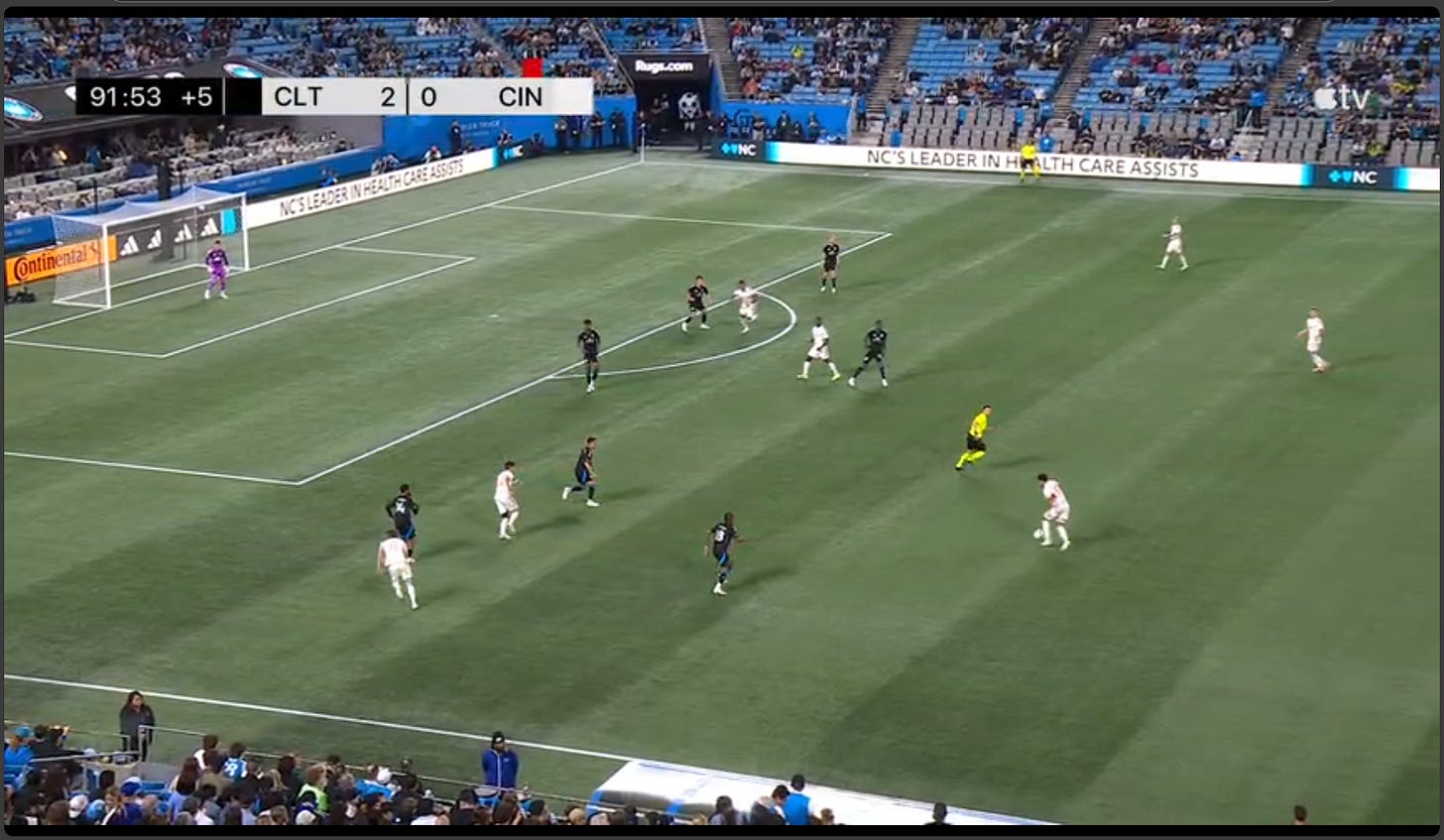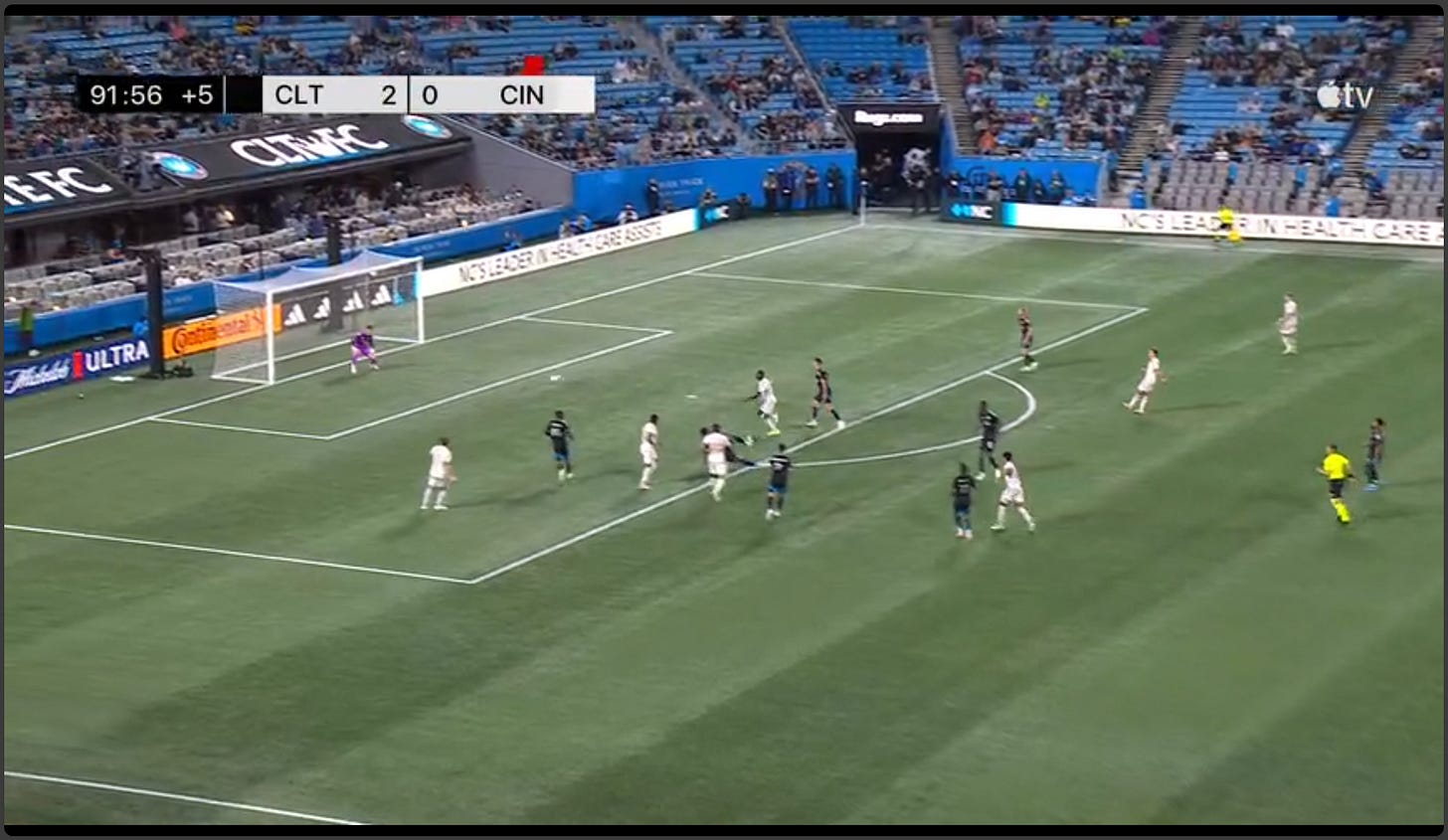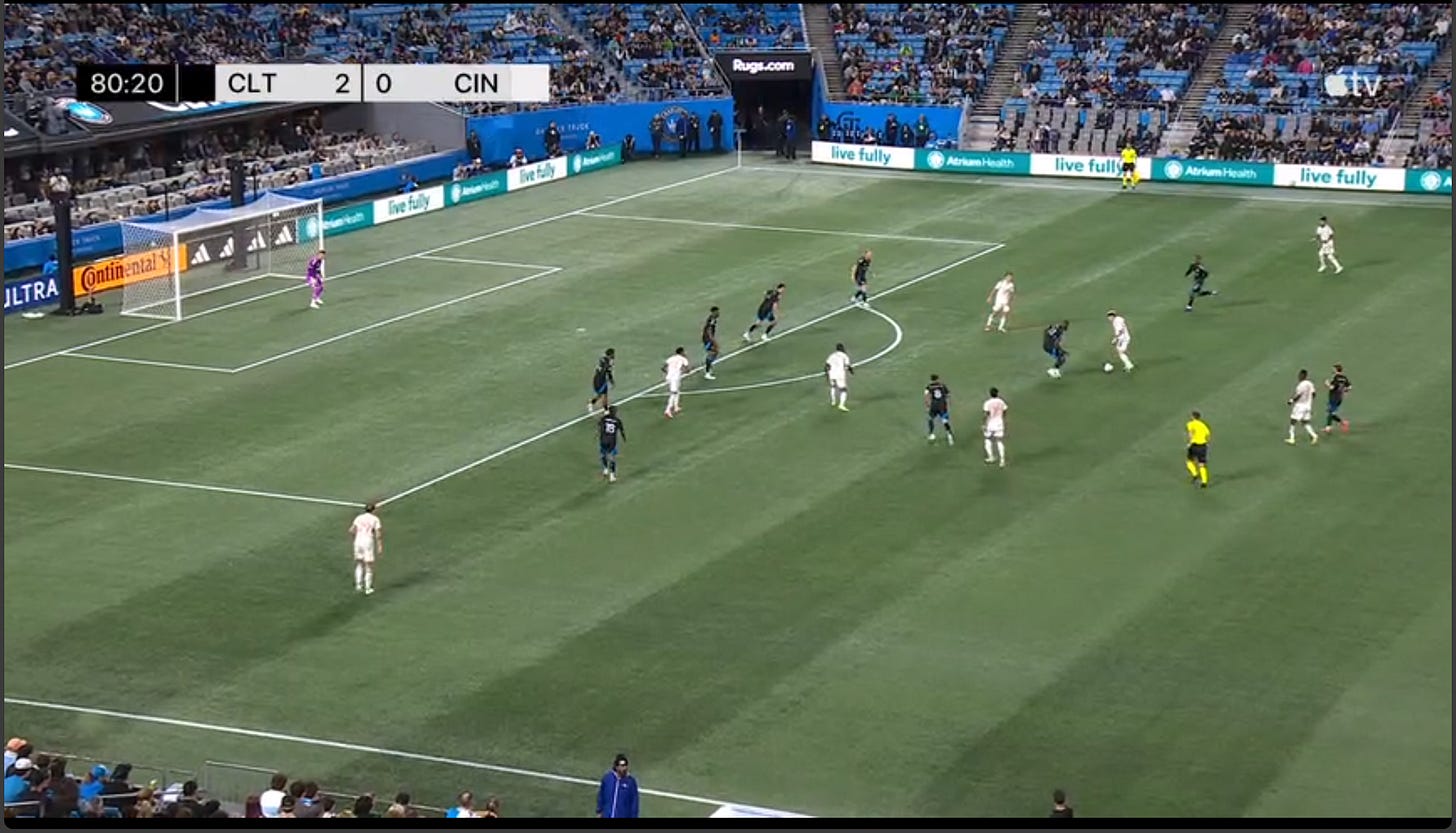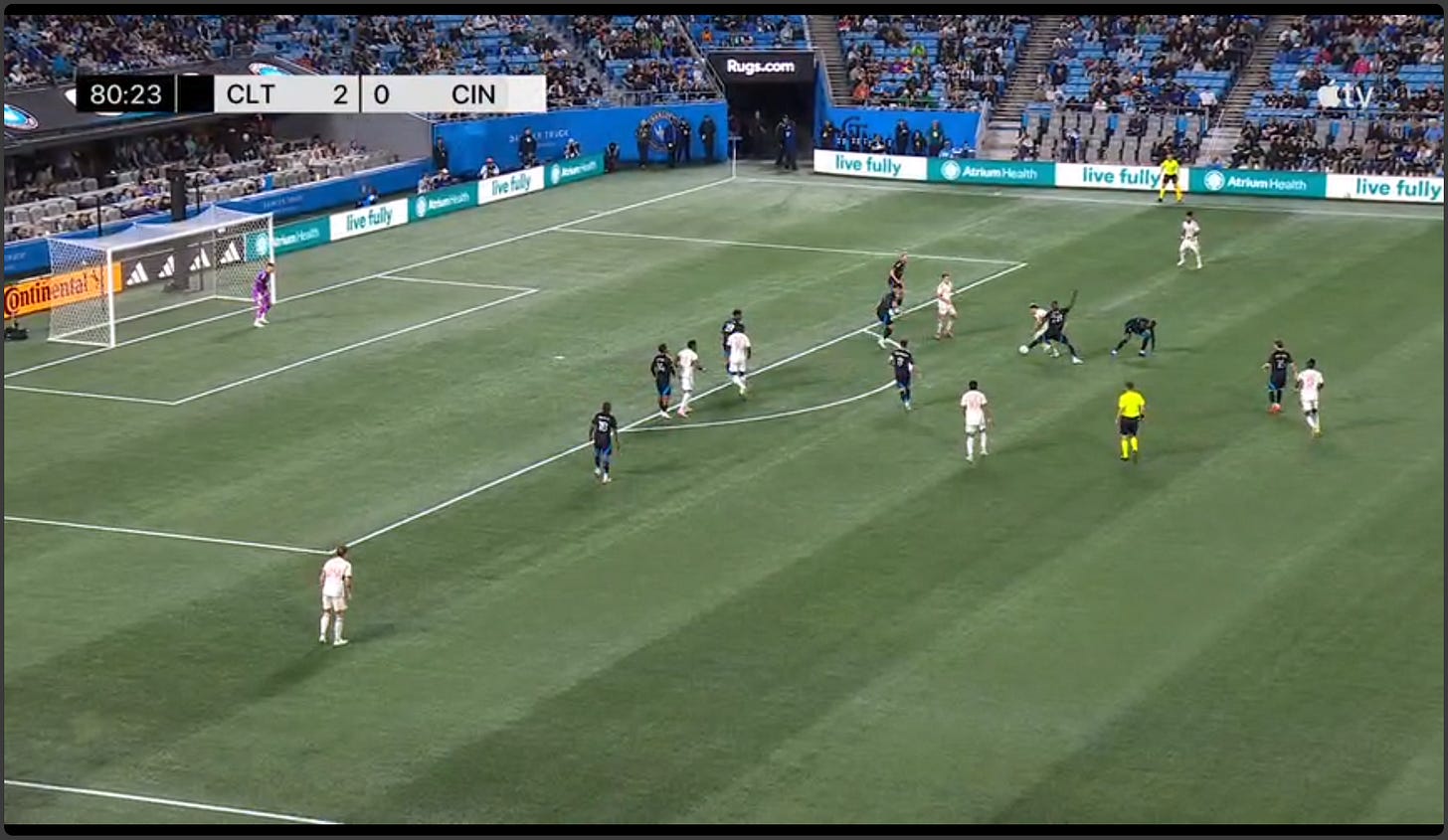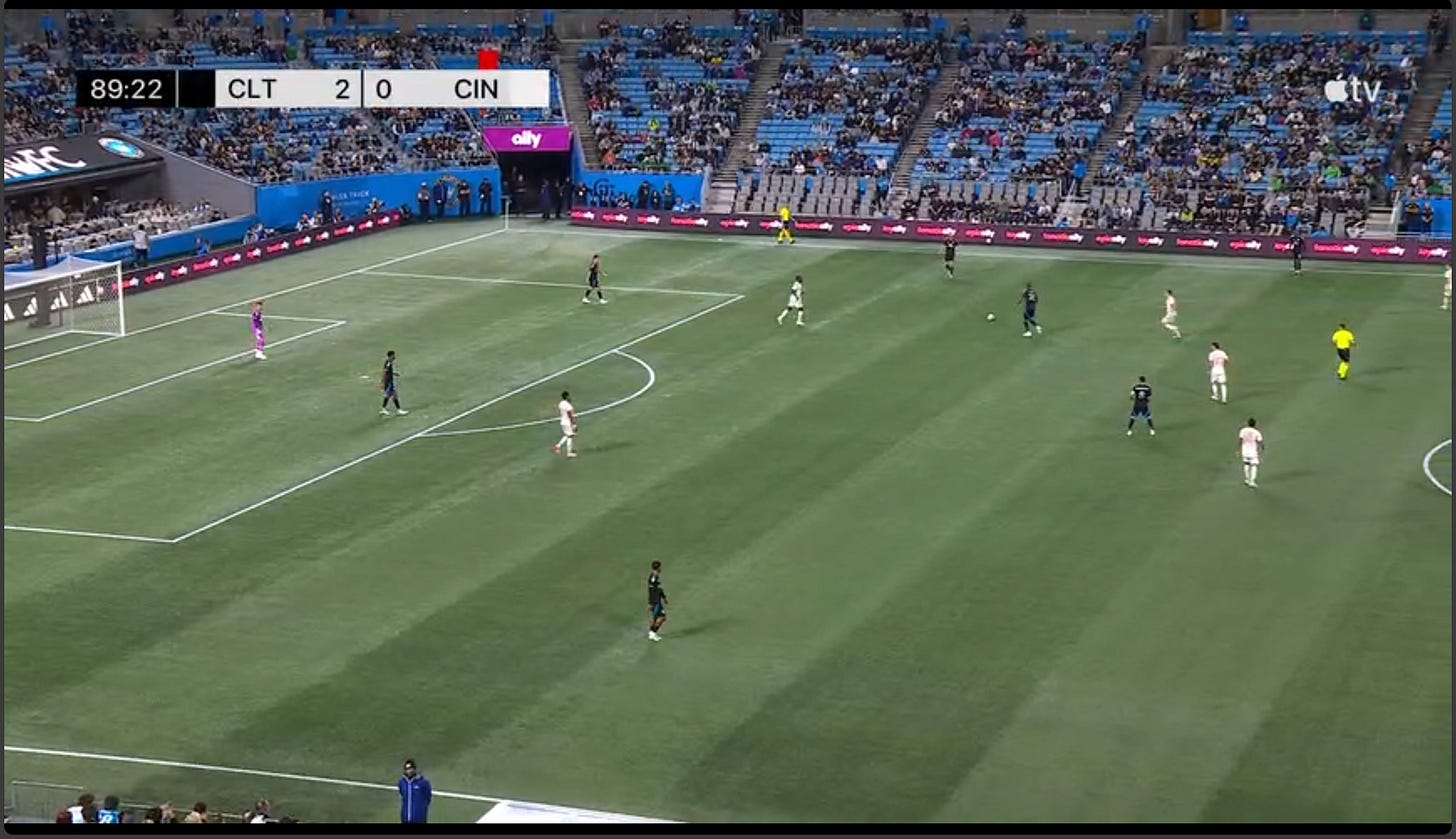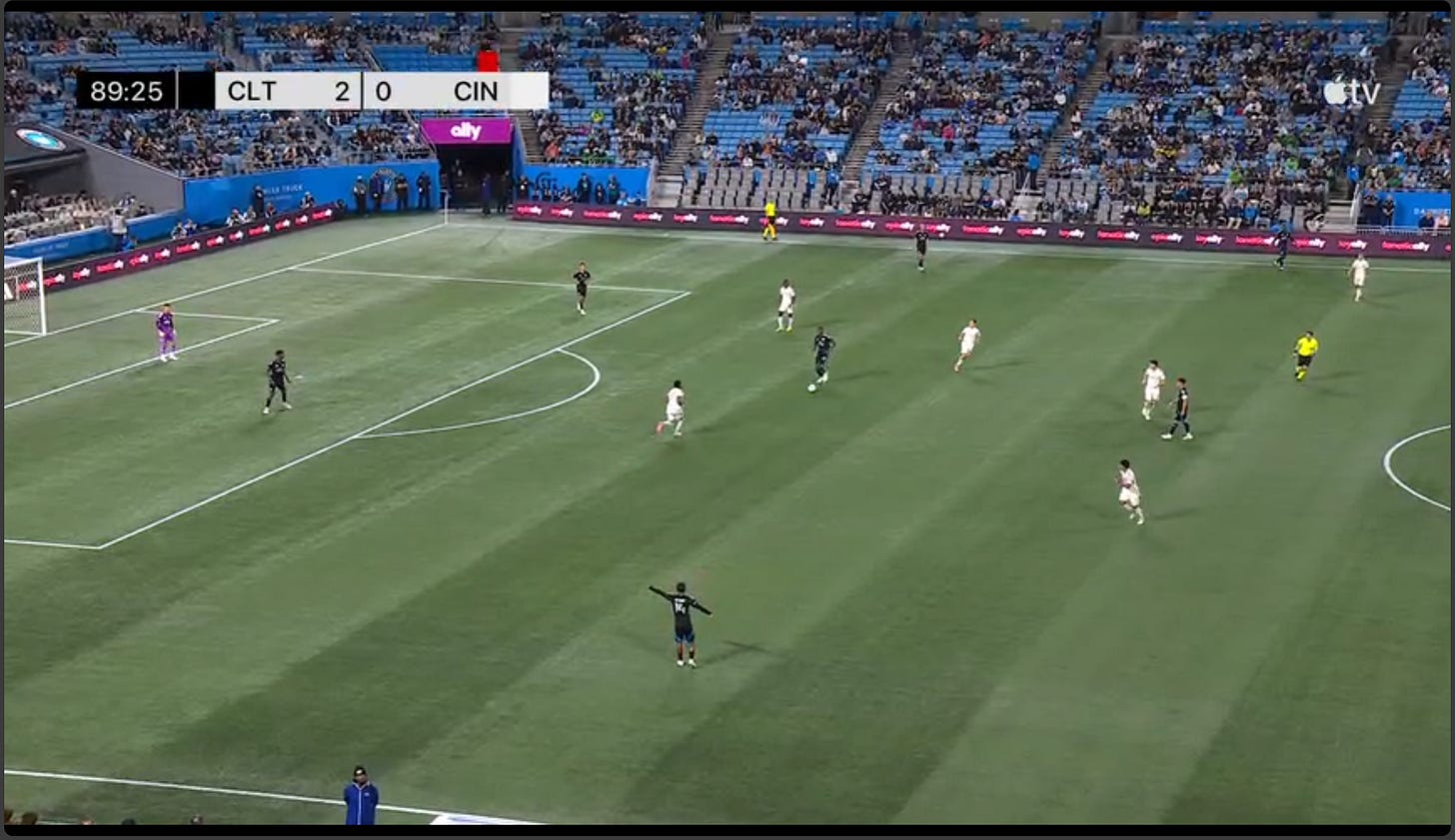Film from the Fortress: CLTFC vs FC Cincinnati
How Charlotte exploited Cincinnati's defensive lines and their defense carried a poor press to get a CLTFC home win.
Charlotte’s 2-0 win over FC Cincinati was their best game so far this season. We were finally able to build up through our opponent’s mid-block and it allowed our attackers (particularly Biel and Agyemang) to cause problems. But as we analyze what made Charlotte successful in this game, I also think about what is repeatable and is an improvement on our part, and what was game specific. FC Cincinnati’s setup was different than our other 3 opponents creating different opportunities and threats. So, let’s dive into the film and understand how Charlotte played through the press and how Biel and Agyemang took advantage of it. Then we are going to show how both Abada and Zaha have adjusted their positioning on each wing. Last, we will look at our defense and how our back 4 and Kahlina had to bail out a poor pressing performance. But first…
Hi Southeast Soccer Report!
A super quick introduction, I’m planning to write weekly articles this season covering Charlotte FC. If you read my introduction post or any of my previous articles on my page, you’ll see that these are long writeups, focused on understanding tactics and patterns and my writeup is accompanied by game screenshots as examples. Whether you’re a CLTFC fan or just love a good deep dive, I hope you enjoy these posts. Ok, back to the game analysis.
Topic 1: Exploiting 1-man defensive lines
This was our best offensive game of the season so far and allowed our talented attack to play to their strengths. The biggest factor in this game was how FC Cincinnati (Cincy for the rest of this post) setup their press/midblock.
Cincy setup their defensive press in a 1-4-1 shape as shown below. This is different from the 2-4 press Seattle showed and the 1-3 press of Atlanta and Miami. In this press, Denkey (#9) pressures the center backs from the side trying to prevent them from switching the field, Evander (#10) and Bucha (#20) are the central players in the line of 4 and they marked our two pivots (Westwood and Bronico). The two wingers will try to cut off passing lanes and cover the full backs, and that leaves Nwobodo (#5) to cover our attacking midfielders behind the line of 4. The idea here is to cover the pivots, force the team to one side, and eventually make them go long.
The problem is Charlotte is already bad and building up through our pivot players. By having two defensive lines with only 1 player on them, Cincy is giving our center backs time to step forward and look to pass and giving tons of space for Biel and Zaha to operate in past the line of 4.
This image above shows how we attack the press. First, Privett has dribbled forward into the space and is looking to pass forward. Second, note we have a double pivot of Westwood and Bronico holding the 2 center players in the 2nd line centrally. Now we have both Biel (near side) and Zaha (central) coming into the space beyond that line of 4 and there is only 1 Cincy midfielder to cover both of them. And lastly, on the very left edge of the screen, Agyemang is pinning the defensive line back by making a vertical run between the fullback and center back. On this example, Privett goes long to Agyemang and the goalkeeper gets the ball, but this combination of our center backs stepping up, our attacking midfielders finding space behind the 2nd line, and Agyemang making those vertical runs was a dangerous combination.
Malanda and Privett’s progressive actions
With just one player on Cincy’s front line, our center backs had time to dribble forward and looked to break the press with their passing.
Malanda had a fantastic game passing and this clip shows his willingness to break the press with his passing. In the clip below Byrne plays the ball back to Malanda and Denkey (#9) pressures him cutting off a pass back to Kahlina. Malanda does not panic and instead cuts up field and dribbles forward.
From here he picks his head up and sees Agyemang making a vertical run between Cincy’s center-back and left-back and finds him with a beautiful ball.
It winds up being a weak shot but it is still threatening. This clip shows we don’t have to play short, but there is a difference between a pressured clearance causing a 50/50 ball and having time and space to pick out a long ball with purpose (see the first clip of my Seattle game review for how this one is different).
Privett also had a willingness to dribble forward and initiate build up. Here from a goal kick, we see again Denkey is pressing from the side and Privett dribbles forward.
While the 4 person line means both Westwood and Bronico are covered, Bronico drifts wide and up field pulling his defender and opening a central passing lane for Biel to run into.
Biel has incoming pressure, but a one touch flick goes to Bronico (who is open since his marker didn’t follow him forward) and we go onto the attack 4 versus 4.
As we continue with examples, notice how many start with our center backs having time, facing forward and looking to make a progressive line breaking pass. And a lot of them went to Pep Biel.
Pep Biel: Space Finder
With our center backs having time and only one midfielder to cover our attacking midfielders, Pep Biel was an absolute menace receiving passes in open space and unlocking our attack.
Let’s start with one similar to the last example. Cincy is pressing more aggressively and both Westwood and Bronico are covered on the near side. But Biel without a tight marker floats into the space in the center circle giving Malanda an easy pass through the defensive line.
Similar to the last example, Biel senses the pressure from Nwobodo and does a one touch pass to Bronico who can enter the attack.
That showed Biel stepping into the press to help break it, which he has done before. But this game we finally saw how dangerous it can be when he receives passes beyond the opponent’s midfield line and can challenge the defensive line.
The example below exemplifies how Biel kept working to find space. He starts with the ball out wide on the left since Zaha has drifted into the half space (we will cover Zaha later).
As play cycles back through Ream eventually to Malanda, Biel drifts back to the center. As Malanda receives the ball, Biel sees the space in the right half space and starts running into it. Of note, a second before this clip Biel points to where he wants the ball and now Westwood is also in this clip directing Malanda to play it to Biel.
Biel receives the ball and once again Nwobodo is a step behind him. Biel does a nice one touch pass back to Westwood.
Now Westwood receives the ball with no pressure on him, no incoming pressure, he’s facing forward allowing him to play to his best strength and try to find a lofted pass behind the defense. And Agyemang is positioned on the back line between their right back and center back ready to run onto ball.
The goalkeeper beats Agyemang to the ball by half a step. But this example shows how well Biel can move and operate in space and how it enables our other players to be in better positions to attack, create and score.
Biel was always a step ahead of Nwobodo this game. Below shows once again that Cincy’s line of 4 is marking our immediate options well, but there is too much time and space for Privett and Biel to just work past that defensive line. Here, Privett looks up and sees Biel running into the open space on this near side.
I love what Biel does next. As he is receiving the ball he slows down and shields the incoming pressure from Nwobodo, letting the ball run across his body. He then sprints forward dribbling at the defensive line and leaving his marker in the dust.
And from Privett having the ball 5 seconds ago, we get a transitional attack with Biel running at Cincy’s back line with 3 options.
Countless times, Biel found himself with the ball and able to turn and face the back line with limited pressure. And the biggest beneficiary of this was Patrick Agyemang.
Topic 2: Agyemang Unleashed
In my Atlanta review I talked about Agyemang being our advanced forward and noted:
While advanced forwards can score a lot of goals, most of the work is a thankless job requiring a ton of effort, and their chances are reliant on the service from their teammates.
In the first 3 games, Agyemang had to fight for 50/50 balls and half chances, primarily relying on his physicality to challenge opposing center backs. With our successful build up and Biel getting the ball in space, Agyemang was able to challenge Cincy’s center backs with his pace. All game, Agyemang made vertical runs between a center back and full back and consistently beat his center backs using his pace and physicality.
Let’s start with the example below. We just won a ball off a turnover and as Ream moves forward, Biel moves off his marker and is sitting open in space.
As Biel is receiving this ball, Agyemang immediately starts this vertical “seam-run” between the center back (Robinson, #12) and right back (Yedlin, #91).
Biel quickly turns and plays the through ball and Agyemang just has one player to beat. The shot gets blocked, but this is the play that Robinson gets injured and is quickly subbed out.
I want to quickly highlight that this play (and the future ones) is why building up through the center is so critical. By playing the ball through the press to our advanced playmaker (Biel), we can create transition like chances from in possession. This vertical seam-run is where Agyemang looks the most dangerous and we unlock these from successful buildup.
With Robinson subbed out, Agyemang starts to feast on the center backs. Here Bronico makes a tackle and it falls to Zaha who immediately lays it off to Biel running forward and we are on the attack. Note Agyemang’s positioning and immediate desire to push the back line and get through.
Biel plays another clean through ball splitting the 2 center backs and Agyemang looks through on goal. His near side defender (Flores, #3) pulls him to the ground and earns a yellow (I honestly thought it could have been a red).
Another thing to highlight is how well Agyemang uses his body and positioning to get inside the center backs. This helps create an easy lane for Biel to spot and thread a pass through.
Now we’ve covered the trifecta, so let’s put it all together for our second goal. Our goal actually starts with Ream having the ball and being forced backwards. Malanda calls for the ball but Ream plays it back to Kahlina. Malanda sees he has no pressure on his side so he sprints back (shown below) so he can turn and receive Kahlina’s pass facing forward.
Malanda receives the ball and has no pressure on him and plenty of time to survey the field. As Cincy sets their defense, Nwobodo is central near Westwood and Biel finds open space on the far side.
Malanda makes a fantastic pass through the press right into the feet of Biel. He turns and immediately looks to play a through ball and he’s got our 3 best goal scorers as options.
Agyemang who started more central has shifted as Biel is receiving the ball and now he is between the center back and right back and he makes another vertical seam run. Biel plays a through ball and Agyemang is 1 on 1 with the center back.
Agyemang uses his pace to get about a half-step in front of his marker and the combination of his pace and physicality prevents a tackle or shot block. He takes a dribble into the box and slots home his first goal of the season.
These runs and this threat that Agyemang poses is where he is at his best. Using his pace and physicality to make the defensive line drop and respect his ability to get in behind is where he can shine as our advanced forward.
Topic 3: Wingers Positioning
Another improvement this game was the spacing, positioning and usage of our wingers, Zaha and Abada. In previous games, Zaha has mainly operated on the left wing while Abada has played more in the right half space. In this game, we got out of those habits leading to better creation on both wings.
Zaha drifting centrally
Most often, Biel plays as our primary advanced playmaker, or our player looking for space beyond the defensive midfield line and then trying to initiate the attack. However, this game started to show that Biel is our advanced playmaker unless Zaha wants to be it. We continued to see Zaha play less in the wide spaces and move more centrally to be an advanced playmaker alongside Biel. This allows Zaha to find more ways to create and initiate our offense.
Let’s start with how Zaha can help break a press and initiate an attack by himself. Here Ream passes to Westwood who makes a quick pass to Zaha.
While Zaha it still somewhat wide, his body is positioned toward the center and that is where he looks to drive. He shields the pressure from Yedlin on his back and as Yedlin retreats, Zaha dribbles past the incoming pressure from Evander. Through his dribbling, Zaha creates a transition attack with plenty of runners.
I love this intent as Zaha’s quality means he can create chances in ways the rest of our players can’t. I also want to point out how Bronico is wide on the near side essentially replacing the width that Zaha vacated.
The key question is as Zaha plays more centrally, who provides the width on the left side. The answer we got this game was anybody but Zaha and it shows how our offense is going to let Zaha go into the space he wants and we will shift around it. Below, we recycle the ball from the right side to Ream on the left. Zaha and Biel are both central in the penalty arc. Zaha stays put and Biel comes over the left side to provide the width.
Ream plays to Westwood centrally and Westwood gets a clear pass to Biel who is now on the left edge of the box.
While I think Zaha is more dangerous in this spot then Biel, I like the idea of mixing in Biel out wide on the left. Regardless, I think the question of who provides width on the left will be interesting to monitor moving forward.
This next sequence shows how Biel and Bronico work to cover the left as Zaha drifts. Here Zaha is drifting inside (near the referee) from the left wing.
Zaha actually comes all the way to the right half space and Malanda Has a pass into him here but opts not to make it. But notice how Bronico is backpedaling into the left back spot, Biel stays put ready to support if the ball swings to the left, and Ream has pushed up and wide to provide width.
We wind up recycling the ball and just a minute later (same possession) Zaha again starts on the left and looks to drift centrally.
The pass here goes to Ream who gets a pass into Agyemang. Agyemang’s back is to goal but he lays it off to Zaha who is now central. Note how Biel has drifted to the left to provide width.
This shows that while Biel will usually be in that advanced playmaker central role, that Zaha is the primary playmaker when he drifts into these positions.
One last clip shows how Zaha can help in buildup to support Bronico (similar to what Biel did in previous clips). Here Bronico get the ball facing 2 makers and plays out wide the Ream.
Zaha has already drifted more central so Bronico makes a run out wide pulling both defenders with him. This allows Zaha to drop into the press unmarked and receive the pass from Ream.
Zaha has so much room now to drive up field and look to create. But instead he swings it out wide to Byrne who carries the ball into the attack. Byrne carries all the way to the opponents box and lays it off to Abada.
And speaking of Abada, look at his positioning here and how wide he is. That brings us to our next topic.
Abada providing width
I wrote in the Atlanta review (and it was worse against Miami) how Abada tends to drift into the right half space causing our team to have no width on the right side. For at least the first 35 minutes (or so) in this game, we adjusted and had Abada out wide. I think this was a coaching tactical change and our attacks down the right looked way better.
Abada staying wide allows Biel to find space in the right half space to create. Here as Byrne gets the ball from Malanda, Abada continues to backpedal to the sideline.
This keeps the left back out wide and allows Biel to drift into the right half space and receive a pass from Byrne.
Byrne above could go wide to Abada or inside to Biel. With better timing and anticipation Biel could play Abada through if Abada makes a run as Byrne starts this pass.
Let me clarify, Abada does not have to only be wide, he just has to start wide and use his movement and positioning to create space for Biel and Byrne. Below Westwood loops a pass into Byrne. Notice how Abada is still jogging wide toward the sideline. In previous games he would likely be in the half space.
Byrne turns and is able to dribble forward past his marker. As Byrne dribbles wide Abada starts running inward toward goal. This provides a through ball option for Byrne and pulls the left back centrally allowing Byrne to carry the ball all the way to a dangerous crossing position.
Byrne whips in a cross toward Agyemang and because the defense is still retreating on this cross, the center back struggles to make an effective clearance. The ball falls to the top of the box and Zaha gets a great shot.
Abada never touches the ball here, but that simple change from starting centrally to purposefully starting wide enables this attack.
Not only does Abada’s width benefit his teammates, it puts him in better attacking scenarios. This next buildup starts with a long pass from Kahlina to Ream, Ream then passes to Zaha who is in the left half space and Zaha looks to create.
As Zaha takes a few dribbles centrally, he sees Vargas (who subbed in for Abada) unmarked out wide on the right side. Look at the space Vargas gets into when he receives this pass.
Now imagine Abada here with the ball able to pick up speed and run at one defender. These are the opportunities we want to create for both Zaha and Abada to use their speed and skill to win a 1 on 1 and create a chance. Here Vargas slows down play and Byrne is sprinting forward on the overlap. Vargas gives it to Byrne who gets a great crossing/cutback opportunity form inside the box.
Notice how Vargas started wide even though the ball was on the left and then comes into the half space as we near the penalty box. I think that movement of starting wide and drifting in as we enter the box is where Abada can thrive both as a dribbler and a goal scoring threat.
Let’s look at one last example that shows the best of Zaha being central and Abada staying wide. Zaha gets the ball in the left half space and faces his defender. Notice that Abada is still wide at the edge of the box.
Zaha now looks to attack and create on his own. He cuts left past his initial defender and then cuts central to essentially take on 3 players of Cincy. With his dribbling Zaha has moved the ball from 30+ yards out to inside the box.
As Zaha cuts onto his right foot he gets double teamed and doesn’t have room to shoot. He picks his head up and Abada has drifted into a great space on the edge of the box.
I love Abada’s decisiveness and quickness. He opens his body to receive the ball and takes a touch with his right foot putting the ball in front of him where he can run up and take a shot.
This shot gets blocked, but this is positive from both of our wingers. Zaha creates an opportunity that only he can create on this team with his dribbling and quality and Abada gets into a good position, receives the ball well, and is looking to score.
Abada’s goal
No clips here but I just want to mention Abada’s goal. The goal is less an attack and more a defensive mistake on a clearance. But Abada did show his ability to dribble with pace as no one could catch him once he was through around midfield. I also liked his decisiveness and shot power. Maybe he could have passed it across to Zaha, but he looked up, didn’t see it, then looked at goal and rifled a nice low shot.
Ok that’s all for the offense, let’s take a look at our defense.
Topic 4: Poor pressure, great defense
Despite the clean sheet this game felt like a step back defensively. Kahlina and our back 4 were fantastic today, but they had to be because our press and pressure on their key playmakers was poor most to the game. After our press protected our back line in the past 2 games, this one felt like we reverted back to the Seattle match.
Time and time again, Seattle easily played through our pressure creating chances against our defense. Let’s take a look at an early game example. They’ve already broken our press a few times but this one highlights our main issues. The first issue is Cincy had a unique build up structure. Their 3 midfielders, Nwobodo (#5), Bucha (#20) and Evander (#10) all fluidly would move in and out of buildup sometimes playing with 2 pivots, sometimes 1, and sometimes 3 (kind of). You can see below that all 3 midfielders are on the same line somewhat within our press.
The second issue may have been our tactical setup. It seems we either were ok with not putting pressure on their center backs and instead sitting in this mid-block or our players did not know who they should mark. Usually either Biel or Agyemang is right in front of their midfield pivot but Nwobodo is somewhat open between both of them. Cincy’s center back plays a direct pass right to him and he turns without being pressured.
And this kind of leads to the 3rd issue which was a lack of energy or commitment to getting pressure on the ball. There is no reason that their main pivot should have as easy a time receiving and turning with the ball as he does above. He plays to Bucha who is open who then plays it out wide to Orellano (#23) who has a clear run at Ream.
Ream does a fantastic job keeping him wide and off his stronger left foot and with Bronico tracking back they make the tackle. But this was the common trend on defense; Cincy easily breaks our press and our defense bails us out.
In the example below the beginning of the play was cutoff by a replay but this is from a goal kick and within a few seconds they have played the ball to Bucha (near the ref) who turns and finds Evander wide open running at our defense.
Evander plays wide to the left mid Kubo who dribbles it into the box and cuts back onto his right foot.
From here, Evander gets a shot at the top of the box that’s saved by Kahlina and from the rebound Cincy makes a dangerous cross. Kahlina saves us but it is another chance after the buildup is too easy.
Cincy used multiple ways to play through our press. We do not pressure their center backs here and (in a throwback to the Seattle game) Denkey drifts from the main line to in between our 2 center backs and 2 midfielders.
He receives the ball in a pocket of space and turns to start running at the back line.
From here Malanda steps up and Denkey has a through ball to Kubo but he plays it slightly behind him and Charlotte dodges another dangerous play.
Even in our mid-block, Cincy found ways to play through. And when we pressed against their defense, it was usually uncoordinated and ineffective. Here Biel shows some energy and presses the center back. When the center back passes back to the goalkeeper Biel continues his run and curves his run so the goalkeeper needs to play to his right side.
As the goalkeeper receives the ball, his only options are clear it long or play to the right side center back. This is our trigger where the whole team can press and force a turnover, but nobody matches Biel’s energy or commitment. Agyemang jogs to close down the center back and Zaha does not close down the right back (Yedlin). In fact Yedlin gets 3 touches without pressure and can pass to Nwobodo who is unmarked in the pivot.
As Nwobodo turns Biel runs back to pressure him, but because he started the press he’s too far forward. He winds up grabbing Nwobodo’s arm and it would have been a foul had the ref not played advantage.
Westwood expects the foul to be called and switches off, giving a free pass to Evander standing at the center circle and he runs straight at our back line to create an attack.
Failing to pressure Evander
Evander is Cincy’s most creative and dangerous offensive player and yet we allowed him way too much time and space on the ball to create. Part of this is because of his movement and positioning. Evander would help in buildup as a deeper midfielder and then arrive later into the attack making it hard for our defensive lines to naturally mark him (this is similar to what Westwood does for us). The problem was not that he got open in these spaces. The issue is when he got open, we did not pressure him enough allowing him to create.
Below comes from a throw in where the ball eventually gets to Evander. This does not seem too threatening as our midfield line of Westwood and Bronico is able to face him and “shield” our center backs from having to press him. But Westwood sits in his current position giving Evander a few yards of space and plenty of time to spot Orellano at the bottom of the screen.
Orellano gets a touch in just ahead of Ream and gets by him and now our back line is exposed. Denkey starts to make a run into the space beyond Privett.
Orellano gets it through to Denkey but as he goes to shoot Malanda makes a great tackle winning the 1 on 1 battle.
Even though Westwood was in front of him, just standing in front of Evander is not good enough. There needs to be a quick close out applying pressure and putting a tackle in to disrupt his ability to create. Here below Westwood again is right in front of Evander and Evander just waits with the ball for a few seconds as Santos (#17) makes a run in behind.
He does not need much space and he threads a through ball past Malanda and into his striker.
From here Santos tries to shoot and Privett wins another 1 on 1 by getting a block in.
On an aside, Santos came in at the 72nd minute and he essentially became a second striker alongside Denkey. The example above and the next one show that two strikers does put additional pressure on our center backs, especially where a creative playmaker has time to find a pass.
At the risk or repeating myself, here is Evander again standing over the ball with Westwood standing a few yards in front of him and nobody actively pressuring him. Near the box you can see Santos starting to run across Privett into a similar space behind Malanda.
Evander finds Santos with a lofted pass. Santos heads it back to the center and fortunately no Cincy player is there to get a shot off.
And the last example is Cincy’s last attack of the game. The ball gets cleared out and as we are regaining our shape Evander once again is on the ball.
The problem is not the space he is in, it is the fact that neither Westwood nor Diani are sprinting out to pressure him. Evander dribbles what seems like 10 yards and then rips a long range shot that bounces in front of Kahlina.
Kahlina should and does handle this but it just shows how much we let their best offensive player create with time and space.
End on a positive
I’m going to close out this topic by saying once again how good our defense was today. Ream shut down Orellano early in the game to the point where he stopped trying to create out wide and shifted centrally. Malanda and Privett not only passed well in buildup, but continued to win 1 on 1 challenges against strikers like they have all season. And Kahlina with 7 saves on 1.4 PSxG (check FBRef for explanation) is incredible. Our defense is one of the most talented ones in the MLS, but I don’t think relying on them as much as we did this game is sustainable. We need our mid-block and sometimes our press to limit the amount of times and how our opponent can attack our back line.
Quick Topic: Diani deserves more minutes
I'll keep this one quick, I think Diani has shown in his limited minutes that he should play more because he can do specific actions that none of our other midfielders can.
Let’s start defensively where Diani simply just had more length and tackling ability than the rest of our midfielders. Here Orellano receives a pass and Diani quickly closes down the space.
Zaha jumps in and double teams Orellano but he somehow keeps the ball and seems like he’s about to break free. However the ball is slightly exposed and Diani makes a lunging clean tackle to dispossess.
Outside of Malanda and Privett I don’t think anyone else on our roster has the ability to make that tackle in that position.
Offensively, his ability to dribble and turn in the press is a different way that we can try to play through our pivots. Below, Kahlina just made a save and rolls it out to Privett as we try to buildup. Cincy has ramped up their press into a 2-4 with 2 strikers. As Diani receives this ball note how a Cincy midfielder is running forward to try to pressure him and prevent Diani from turning.
In this position Westwood and Bronico would probably play it to Ream as they are facing him and they cannot open their body to face forward due to incoming pressure. But Diani instead turns 90 degrees centrally and dribbles into the middle of the press. This takes him away from pressure and also brings pressure from one of the strikers that was covering Malanda.
This action has shifted the press and now Diani can give it to Malanda who is facing forward and no longer has pressure on him. Malanda goes long and finds Toklomati who heads it to Williamson and we wind up with Toklomati getting a pretty good shooting opportunity.
I am not confident enough to say that Diani needs to start for this team. But I think even in his limited minutes he’s shown that he can uniquely contribute to this midfield and I think we need to see more of him to see what he is fully capable of.
Conclusion
This was our best game of the season so far but I’m unsure how much of this success can translate to future games. Our buildup looked way better, but a lot of it was due to Cincy giving our center backs time and giving Biel and Zaha space to operate in. Similarly, our defense looked good, but if we do not pressure their buildup and key playmakers with more intensity I don’t know how much we can keep leaning on our defense.
Overall I am cautiously optimistic about CLTFC, we played 4 teams that all have a realistic chance to win the MLS Cup this year and got 7 points from it. Our defense (and goalie) still look like one of the most talented groups in the league. And now we’ve seen Biel pick a part a defense, Zaha create something from nothing, and Agyemang be a problem for any MLS center back. The upcoming match against San Jose is the first time this season we should be clear favorites to win. I’m excited to see how we play and if we can show improvement as our team gets better and our competition (hopefully) gets a bit easier.




